
* A Distributed Proofreaders Canada eBook *
This eBook is made available at no cost and with very few restrictions. These restrictions apply only if (1) you make a change in the eBook (other than alteration for different display devices), or (2) you are making commercial use of the eBook. If either of these conditions applies, please contact a https://www.fadedpage.com administrator before proceeding. Thousands more FREE eBooks are available at https://www.fadedpage.com.
This work is in the Canadian public domain, but may be under copyright in some countries. If you live outside Canada, check your country's copyright laws. IF THE BOOK IS UNDER COPYRIGHT IN YOUR COUNTRY, DO NOT DOWNLOAD OR REDISTRIBUTE THIS FILE.
Title: Round the Year with Enid Blyton—Autumn Book
Date of first publication: 1934
Author: Enid Blyton (1897-1968)
Date first posted: May 29, 2019
Date last updated: May 29, 2019
Faded Page eBook #20190558
This eBook was produced by: Alex White & the online Distributed Proofreaders Canada team at https://www.pgdpcanada.net

AUTUMN TIME

THE SPECKLED THRUSH MAKES A FEAST OF PRIVET BERRIES

ROUND THE YEAR
WITH
ENID BLYTON
AUTUMN TIME
EVANS BROTHERS LIMITED, LONDON
ENID BLYTON’S NATURE BOOKS
ROUND THE YEAR
WITH ENID BLYTON
A YEAR’S NATURE STUDY
IN FOUR BOOKS
Spring
Summer
Autumn
Winter
In addition to the seasonal books,
there is a library edition, containing
the four books under one cover,
bound in cloth boards
LONDON
EVANS BROTHERS LIMITED
MONTAGUE HOUSE, RUSSELL SQ., W.C.1
Green Hedges,
Penn Road,
Beaconsfield
Bucks.
Dear Boys and Girls,
I wish you could come with me and walk over the hills, through the fields, and down by the river, finding a hundred exciting or beautiful things by the way. I should like to take you fishing in the ponds, and fill your jars with snails and tadpoles. I should like to help you to make a fine bird-table, or to prepare a splendid aquarium. I should like to give you a garden of your own, and show you how to make it a place of bright colours and sweet scents.
But I cannot do all these things—so instead I have written these four books for you, so that you may read them and do for yourselves all the things I would like to do with you. We will go round the year together, and you must discover with your teacher and your friends all the exciting things there are to be found in Nature study.
Good luck to you in all your Nature work, and may you find as much delight in using these books as I found when writing them for you!

| CHAP. | PAGE | |
| 1. | In Our Cornfields | 7 |
| 2. | The Birds Fly South | 15 |
| 3. | All About Shadows | 24 |
| 4. | Bulbs for the Classroom | 32 |
| 5. | Spiders and their Ways | 41 |
| 6. | The Rain and What it Does | 52 |
| 7. | Our Tiny Ploughman, the Worm | 58 |
| 8. | How Seeds Seek their Fortunes | 65 |
| 9. | The Clouds we See | 73 |
| 10. | Our Cats and Dogs | 80 |
| 11. | The Cheeky House-Sparrow | 89 |
To-day I am going to tell you about our cornfields and the different grains we grow there. Even town children know corn when they see it, for little sheaves of it are always brought to decorate our churches at harvest-festival time. Country children know it well, because their fathers have to do with its sowing and reaping.
Why is corn so important to us? It is because we get from it the flour to make our bread and our porridge; it is our chief food. We ought to know something about it, and we ought to be able to tell the different corns from one another.
Our cornfields are very lovely when the corn is ripe. It is a rich gold colour and waves beautifully in the wind, making a whispery, rustling noise. Red poppies peep here and there, corn cockles shake out their pink petals, and the scarlet pimpernels glow as if they were on fire, set close to the dry ground. These flowers are weeds—it is the golden corn that is the farmer’s joy.
Look at it. What does it remind you of? It is very like a giant grass, isn’t it? It has long narrow leaves like grass, a jointed stem, and the spike of corn at the top reminds us of flowering grasses. Corn is simply a cultivated grass. Just as we have little wild strawberries and big garden strawberries, small wild poppies and big cultivated ones, so we have wild grasses in the hedges and big cultivated grass in our fields—the wheat, barley and oats we see growing in the country.
Our fields of corn are small compared with those in America or Canada. There you may see corn stretching right away to the skyline, waving in the hot sun—miles on miles of corn, so much that you might say, “But who will eat all that!”
We cannot grow enough corn in our own country to feed our people, so other parts of the world grow it for us. Is there a map in your atlas showing the corn-lands of the world? Look and see. If there is, you will be astonished to find what a great deal of the earth is used for growing corn.
How many different corns do you know the names of? Wheat is one. Barley is another, and oats. Then there is rye, too, but it is not grown in our country so much as the others. There is yet another corn called maize, or Indian corn. In Longfellow’s “Hiawatha” poem you will find a fine story telling how the gift of maize came to the Red Indians. You will like to read it.
We call all our corns cereals. The name cereals comes from Ceres, who was the goddess of farmers and who loved to look after the crops and fruits of mankind. Do you eat cereals for your breakfast? If you have grape-nuts, shredded wheat, post-toasties or any of those kinds of foods, you have cereals. They are all made from corn.
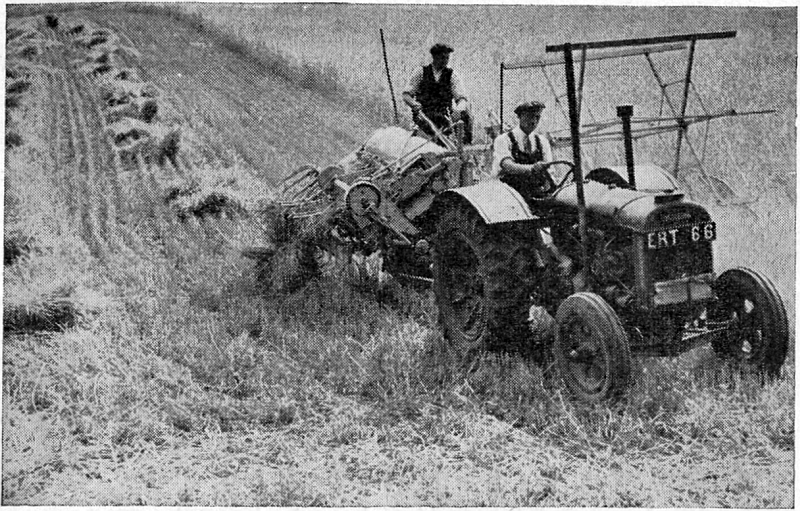
A CLEVER MACHINE THAT CUTS DOWN THE CORN AND BINDS IT INTO SHEAVES FOR THE FARMER
The corn you perhaps know the best of all is the wheat. Have you an ear of wheat there? An ear is simply a stalk of corn with all its grains. Look at your ear of wheat. Do you see the yellow grains packed closely together on the stalk, each with a spiky tip? They are the seeds of the corn. Pull some off and look at them. If you had seen this ear in June, when it was green and unripe, you would have seen big stamens hanging out, with large anthers (the tops of the stamens, where the pollen is kept) swinging in the wind, and you would have seen feathery stigmas, too, all ready to catch the powdery pollen.
Wheat does not only give us the flour for our bread. It gives us the macaroni we sometimes have in our milk puddings. Do you have puddings of semolina at home? That is made from wheat, too, and so is the vermicelli you may have tasted in puddings as well. Shredded wheat comes from wheat, of course, and so do puffed wheat and the funny brown grape-nuts some of us like so much for breakfast. What a lot of different dishes we make from our ears of wheat!
Here is a very bristly, bearded ear of corn. It is barley. You may have picked wild barley grass in the meadows and have played a sly joke on your companion by pushing the bristly head up his sleeve. When he tried to get it down, the bristles stuck tight into his sleeve, and unless he managed to turn it right round he could not pull it out, but had to leave it there, bristling uncomfortably!
The grains are very neatly and tidily packed together and the bristles are long. We can easily tell barley from wheat because of its long beard. What is barley used for? You are sure to have seen the packets of barley that mother takes down from the shelf when she wants to put barley into the soup or into a stew. They are hard little grains, but when we see them in the soup they have swelled up and are big and soft.
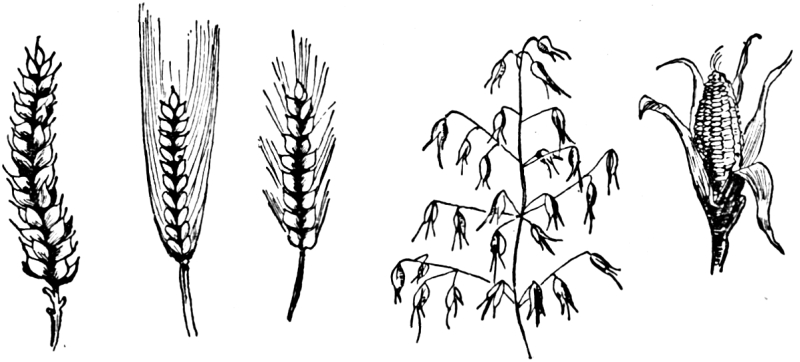
Left to right: WHEAT, BARLEY, RYE, OATS and MAIZE (a head of maize is really much bigger than the other corns shown)
In some places the barley is made into bread. Most of the barley, however, goes to the breweries and is made into malt, which is used for brewing beer. A good deal of it goes also to the distilleries and helps to make whisky.
Have you any rye to look at? We do not grow it very much in our country. It grows well in colder countries and does not mind poor soil. It is very like barley, isn’t it? What is the difference? The bristles are not so long and the grains are not so neatly packed up the stalk. Bread is made from rye and we call it blackbread, because it is very dark in colour. Look for wild rye-grass in the meadows. There is sure to be plenty there.
Do you know the pretty, feathery oats? Scottish children will know oats very well indeed, for it likes the colder climate of Scotland. Do you have porridge for breakfast in the winter? If you do, you are eating oats, for porridge is made from oats.
Oats are made into bread, too, and into biscuits and cakes. Have you had oatmeal biscuits? There is a very useful animal who likes oats as much as we do—and that is the horse! Look at him putting his nose into his bag of oats—how he enjoys it!
Perhaps some of you grew grains of maize when you tried germination experiments in the spring-time. Do you remember the queer-shaped little golden grains? If we keep hens or pigeons we know what maize is like, too, for we give it to the birds to eat. Sometimes we have it in a pudding, for cornflour comes from maize. Has anyone seen it growing?
It is grown a great deal in America, and there it is the chief cereal. It does not look very much like corn when it grows. It shoots up very tall, taller than a man, and has stems rather like bamboo, with large, broad leaves hanging down from the joints. At the top is a thick spike, and inside it are hundreds of maize grains, packed as tightly as can be, ripe and yellow. Ask your greengrocer to show you a head of maize if he has one.
The corn does not have flowers such as the buttercups, poppies or dandelions have. When it is in flower in June or July we see no brightly coloured petals glowing in the sun. There are no petals to see—only stamens and stigmas, shaking loosely in the wind. It is the wind that takes the pollen from the stamens and blows it on to the waiting stigmas; so there is no need for the corn to waste time and energy on pretty petals or sweet scents, for the wind has neither eyes nor nose. Those flowers that need the help of bees, beetles, flies or moths provide colour and scent, for these insects are attracted by brightness and sweetness. The corn merely hangs out its stamens for the wind to shake when it goes by, and hopes that some of the pollen will fly to the feathery stigmas; and, of course, it does, so that the ears of corn ripen into good grain and give us the food we need.
Men reap the corn and it is taken to the mills to be ground. The husks are separated from the grain and are used as bran, which cattle like to eat. The stalks of the corn become dry straw, and we use it for many things—thatch for cottages, bedding for cattle and for dogs in kennels, and we also put it under our strawberries to keep them from being spoilt by mud, when it rains. Can you think of some other uses?
Go out into the meadows and look at the wild grasses. How many different kinds can you bring back with you? Do we use these grasses as we do wheat, barley and oats? No—but the farmer finds them very useful in another way. He grows them as grass for his cattle, and as hay for the winter-time. Have you seen hay-meadows! Aren’t they lovely, scattered with golden buttercups and white moon-daisies with the red sorrel sticking up here and there? The hay is cut, dried and built into stacks, and the cattle are glad of it when the long winter is here and there is little fresh grass to eat.
See if you can find wild barley, rye-grass and wild oats. Bring back as many other grasses as you can, and try to find out their names. Look for the loose stamens and shake out the pollen. You will be surprised to find what a lot of different grasses grow under your nose, never noticed by you before!
THINGS TO DO
Go to see a cornfield if you can. Listen to it whispering.
Draw an ear of corn. Pull out a single grain and draw that.
Read the story of Mondamin in the Song of Hiawatha.
Write down three sorts of corn you know, and say what they give us to eat.
Draw three wild grasses. Find out their names and write them underneath.
Do you remember how we listened for the cuckoo’s pretty double-note in the spring-time? We wanted him to come back because his call told us that spring was really here! We listened to his “Cuckoo! Cuckoo!” in May, we heard him change his tune in June—and then, what happened? We heard him no more!
Where had he gone? And why had he gone? The screeching swifts disappeared too, not long after—and now, one by one, other birds are going away from us or have already gone. The willow-warblers, the nightingales, the sand-martins have all said good-bye, and soon the swallows and house-martins will fly away too, and one morning we shall listen in vain for their musical twittering. We shall see them no more until next spring.
They all fly southward in the autumn to the warm lands where the sun shines brightly and insects are easily found. Get out your maps and see where they go to. Find the Mediterranean Sea, Egypt and Algiers. Look for Cape Town at the very south of Africa. “Surely no bird can fly from England all the way to Cape Town!” someone says in surprise. It is certainly astonishing, but quite true.
It has been proved that a swallow from Northumberland flew all the thousands of miles to Cape Town—and even longer flights have been recorded. Another very long flight, which you can trace on your maps, is that of the Virginian Plover, which flies each year all the way from Labrador to Brazil.
In the spring-time our birds fly back to us, and arrive on our shores eager to nest and bring up their young ones. Where they were born themselves is “home” to them, and so great is their instinct for “homing” that a bird will actually fly back to the same village, and find the same tree or barn, where it had its nest the year before! There it will build, and bring up its young ones, and they, in their turn, will perhaps come back the following year and nest in the same village in which they themselves were born.
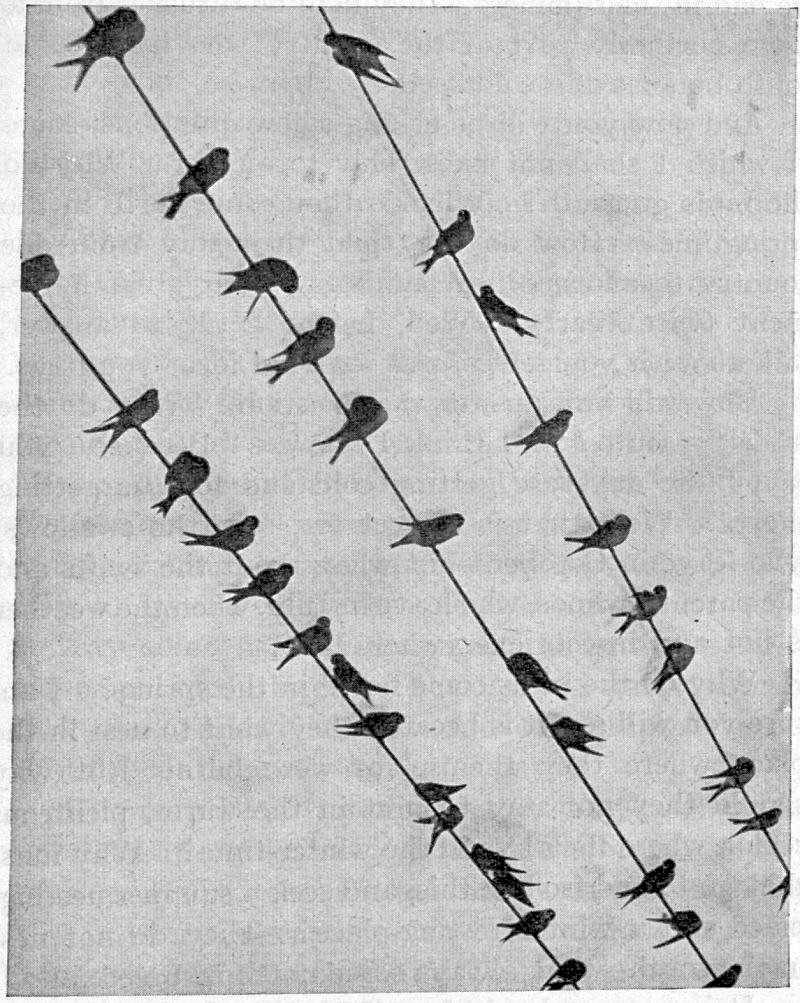
SWALLOWS GATHERING ON TELEGRAPH WIRES BEFORE MIGRATING
Not all birds leave us in the autumn. You will be able to think of many that stay with us all the year round. We call these birds Residents, because they reside or live with us. Let us think of some. Sparrows, starlings, rooks, robins, thrushes, blackbirds, tits—we can see these in the winter as well as in the summer. But even these resident birds sometimes travel about to look for better feeding-grounds; the thrushes we have with us in the winter may not be the same ones we had in the summer. They may be thrushes from a more northerly part of the country who have come south because of a cold spell.
And now you will be asking a few questions, some of which I shall not know how to answer. Why do the birds go south? Why do they come north in the springtime? How do they find their way from one country to another? What began their great movement twice yearly? Well, before I try to answer, talk about it yourselves, and see what ideas you have.
How will you answer the question, “Why do the birds fly south?” I think I know. “Because,” you say, “the days are getting cold and food is getting short.” Well, that is correct for, say, the swallows, who leave in October—but what about the swifts and the parent cuckoos, who leave in July, when the weather is hot and insects everywhere?
Why do the birds come north in the spring? I am sure you will say it is because they want to nest in the place where they themselves were born. But why should they not stay to nest in the warm, plenteous region where they live in the winter-time? Why must they go to and fro like this, and seek a summer nesting-place and a winter resting-place? They do not nest in the south—they always come north to breed.
It is a general rule for all birds in our part of the world to nest in the coldest part of their range, and it is a good rule, for the youngsters are hardier and sturdier then. The birds, however, cannot actually know that—something must have happened at a distant time to start the strange habit of world-wide migration. What could it have been?
Well, we do not really know. Some naturalists say that long ago, when the world passed through a very cold age and glaciers spread down from the north, accompanied by bitter winds, all life was driven southwards. The birds migrated easily, because their wings could take them anywhere, and they flew off to the south to seek the warmth and food they needed. Then, when summer came and the sun melted the glaciers, the birds returned as far northwards as they could, striving to nest where they had nested before, only to be driven south again as winter approached. So, say some naturalists, began the great to-and-fro movement of the birds. The habit was started, became an instinct, and, because it proved good for the race of birds, continues down to this day.
This may be all wrong—but, at any rate, we feel sure that at some time or other in the history of birds some great happening began the habit of migration. It is an excellent custom, from the bird point of view, because to come north in the spring-time means warm weather, plenty of food (when the heat in the south may mean parched lands and food scarcity), long hours of daylight in which to look for food for the youngsters, and a hardy upbringing. To go south in the autumn solves the problem of warmth and food at that season.
How do the birds find their way? “Oh,” you will perhaps say, “that’s easy. The old ones lead the way, of course! They remember it from the last year!”
But the strange thing is that the old ones do not lead the way! Except in a few cases, old and young fly away separately. The young ones fly first, and as they have never before left our shores, how in the world do they find their way? The older ones follow later, except the cuckoos, who leave before their young.
Much of the flying is done at night, when no landmarks can be seen, and a great deal of it is over the sea. Some birds fly close to the water, so that, even if they wished to, they could not see their way clearly! How, then, do they know their way half across the world?
We do not know. Birds have a great sense of direction, excellent eyesight, and a wonderful memory for landmarks, but these things cannot alone account for the wonders of migration. The wind helps a good deal, because, in the springtime a south-west breeze blows, and in the autumn a north-east wind. Birds starting out on their long journey fly straight upwards until they reach a strong current in the upper atmosphere, and then fly steadily onwards.
It is a brave, venturesome thing, this long flight to far countries. The weather may be good at the start, but storms, fogs, gales, head winds, blizzards may arise, and then the flocks of tiny travellers are in a dreadful plight. If they are over the sea thousands fall and are drowned. If a ship or steamer is near, the captain suddenly discovers that hosts of little birds have flown to it and are resting in every corner!
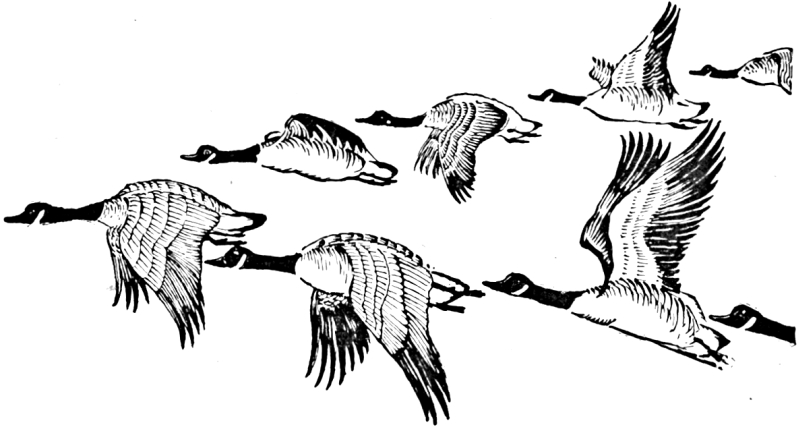
WILD GEESE MIGRATING: THEY FLY IN ARROW-HEAD FORMATION
A lighthouse, with its great white beam of light, attracts hundreds of thousands of weary birds in a storm, and they dash themselves to death against the lantern, or fall dazzled into the sea. Many lighthouses have perches round them for the birds, but there is never enough room for the multitudes that seek sanctuary from the storm.
A great many migrants follow the coast-line when flying, or travel down river-valleys. We know this because such flocks have been seen. Other flocks fly so high that we cannot see them with our naked eye, but must use a telescope. We may perhaps hear their call, but to our eye the sky is quite empty! Many birds fly at night, and these have been seen by astronomers who, looking at the moon through their telescopes, suddenly see great flocks of birds in the night-sky, clearly defined against the bright moon. The birds fly about 30 miles an hour, but may speed up to 60 if they are trying to out-fly a storm.
A great many birds are ringed by naturalists when they are young, and it is these marked birds that tell us such a lot about migration. A ringed bird has a light band or ring round one of its legs, and on the ring is an address and a number. Anyone finding a ringed bird should write to the address, and give the number of the bird, and the place and date it was found. We know then how far the bird has travelled. Set the bird free again, of course, so that it may give yet more information if it is caught a second time. I have never found a ringed bird yet, but I am always hoping to.
The swallows will soon be gone this year. Have you seen them collecting yet? Near my house there is an old barn and also some telegraph wires, and the swallows crowd together in hundreds on the roof and on the wires before they go. Then one evening they rise in the air and fly southwards, and the next morning I cannot see a single one. They have all gone, and I shall see them no more until the next spring-time. Keep your eyes open if you still have swallows about, and watch to see if they collect together in your district—and be sure to notice if young and old are together. The young have shorter tails than the old ones and can easily be picked out.
Famous naturalists say that if only people would notice the birds as carefully as they notice the weather, we should soon solve many of the mysteries of migration, so let us make a start this week, thousands of us all over the kingdom, and perhaps we shall, between us, find out something really worth knowing!
THINGS TO DO
Make out a list of all the birds you are sure you will see in the winter.
Look every morning for the swallows. Put down on the Nature-calendar, or in your Nature notebook, the date of the last day you see them.
Draw a lighthouse with many birds flying round it.
Have you any resident bird in your garden with peculiar markings, such as a blackbird with a white feather or two? If you have, watch for it all the year round, and see if it stays with you.
We have winter visitors as well as summer visitors. The fieldfares are winter visitors. Where do they come from, the north or the south?
You know something about shadows already, because we have spoken of them in another lesson. Look out of the window. Is the sun shining? Can you see any shadows? Is the sun behind a cloud? If so, the whole school is in that cloud’s shadow, isn’t it, and will stay there until the cloud moves away from the face of the sun.
How are shadows made? Think for a minute and then try to say in a few words what a shadow really is. It is more difficult than you thought it would be, isn’t it? I expect somebody has managed to put it into a few words, such as the following sentence: A shadow is a dark patch caused by something blocking out the light of the sun, of a lamp, or of a candle.
Whenever we put something near a light, that object makes a shadow behind it. The light cannot shine right through it, and so there must be a dark patch behind the object where the light cannot shine. That dark patch is the shadow. Hold out your hand the next time the sun shines in at your classroom window. Look down at your desk. Do you see the shadow of your hand? You have blocked out a little of the sunlight, so that somewhere behind your hand is a dark patch, the shadow of your hand. A shadow is simply a place the full light does not reach.
If the sun is shining, we will go out into the playground for a minute. Stand so that the sun shines into your face. Where are your shadows? Yes, they are all behind you. Nobody has one in front of him. Why not?
Now turn round with your backs to the sun. Where are your shadows now? They are in front of you. They did not move round to the back when you turned. Why not? Because shadows must hide from the light, and whether you turn towards your shadow or away from it, it must always be on the side opposite the light.
Do you remember the shadow game (in the Summer Book)? If you played this you found that in the mornings and evenings your shadows were long, and at noon they were short. Does anyone know why that should be?
Someone is sure to know that in the early morning and in the evening the sun is low in the sky, so our shadows are long. At midday the sun is high, so our shadows are short. But why should the height of the sun make such a difference to the length of our shadows?
Let us go indoors again and find out the reason. We shall want a candle or a lamp to be the sun.
Now here is our candle, alight. But it does not shine very brightly in the light classroom, so we will draw down all the blinds. Now that the room is dark our candle seems to shine much more brightly.
Stand in a ring round the candle. Where are our shadows? All neatly behind us! Now one of you must come out and stand where everyone can see him.
Someone must hold the candle level with his waist, but some distance away. Do you see his shadow on the floor? What happens to the shadow when the candle is raised on a level with his head? Yes, it has grown shorter, hasn’t it?
Now hold the candle very low—what an enormously long shadow creeps behind the boy! Now hold the candle very high, and his shadow seems to run right up to him, so that it is short and squat. Hold the candle right over his head—now where is his shadow? He doesn’t seem to have one!
Now do you see why our shadows are long in the mornings and evenings and short at midday? You have seen the sun low in the sky in the early mornings when you get up, haven’t you? It is like a candle held at this level, low down, so that our bodies cast long shadows behind us. As it climbs the sky, it gets higher, and so our shadows become shorter. Then in the evenings the sun sinks low again, in the opposite sky, and our shadows lengthen out.
Does the sun climb so high that it is exactly over our heads? If it does, we shall find that at midday we have no shadows, and everything is a terrible glare. But fortunately for us the sun does not shine from immediately overhead, and so we always have a shadow, either short or long according to the time of day. In tropical countries the sun climbs so high that it is right overhead, and the people in those lands do not dare to walk out when they have no shadows, for the sun is so terribly hot. It beats straight down, and its rays then are fierce and scorching.
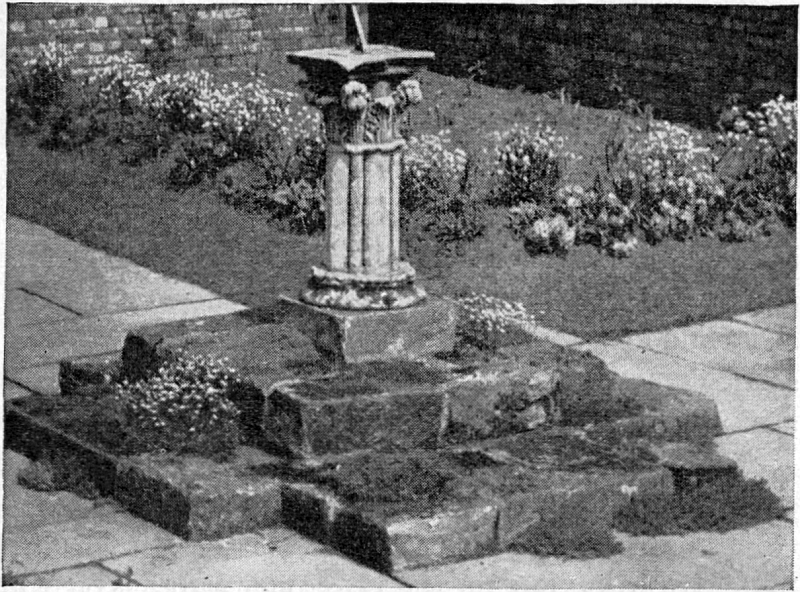
A SUN-DIAL IN AN OLD GARDEN
The higher the sun climbs the hotter the weather. That is why our summer-time is hot—the sun climbs higher then than in the winter. Shall we have longer or shorter shadows in the summer? Yes, shorter, of course, because the sun is higher up. You remember that the higher we held the candle, the shorter our shadows became. Shall we raise and lower the candle again, and watch the shadow grow short and long, short and long? That is just what the sun does to our shadows as it rises in the sky, climbs high and sets again.
Now I should like you all to keep a Shadow Chart to be filled in on a certain day each month, making twelve entries in a year. One of you must also make a big chart to be put on the classroom wall. You will want twelve squares ruled on your chart, one for each month. Your classroom chart may either be one very large sheet of paper with twelve squares ruled on it, or may be twelve small pieces of paper pinned side by side, each to be filled in as the months pass. You only need to have on the wall those sheets you have filled in, but at the end of the year you will have all the twelve, of course.
If you prefer, you may have the same for your own small charts—twelve pages with a chart on each, instead of one large page with all the charts on. Perhaps you would like to make a small book of twelve pages, with a design of sun and shadow on the front, and name it “My Shadow Book.”
Now for your Shadow Charts you must do exactly the same each month. It is really the Shadow Game drawn in your books! Go out into the playground. Choose a spot which you know is ALWAYS in the sun when it shines. Mark it in some way so that you will be able to use the same spot each month.
Now on the same day each month you must do the same thing—you must get a boy or girl to stand on that spot at, say, half-past nine in the morning, at noon, at two o’clock, and at half-past four. One of you must have a notebook, and another must have a measuring tape. Measure the length of the shadow cast, and call out the measurement to the boy or girl with the notebook so that he or she may note it down quickly. If you want to be very exact, make a mark where the tip of the shadow is, and then measure from that tip to the tip of the next shadow when you measure the length again later on in the day.
The next day you can draw the shadow lengths in your books or on your charts. Put arrows to show which way the sun goes, and also put the name of the month and the date. You can make the diagram to scale, using an inch for every foot.
Do this every month and compare the charts with one another. You will see very clearly the difference between morning, noon and evening shadows, and between the shadows cast in winter and in summer. When the charts are all completed, look through them and write neatly at the end what you notice about them and what is the reason for their differences.
How many of you have seen a sun-dial? Not very many, I expect, for people do not need them now, in these days of watches, clocks and wireless signals. Sun-dials were the clocks of two or three centuries ago. They were shadow-clocks. A sun-dial was usually a brass plate on which were marked the hours of the daytime (not of the night). Fixed to the brass face was an upright piece of iron, pointing to the north, sloping downwards. When the sun shone the pointer cast a sharp shadow, and this pointed to the hour of the day. At ten o’clock, for instance, the shadow lay on the figure 10, at two o’clock it pointed to 2. It was thus a kind of shadow-clock, not very correct always and not reliable, because it was only useful on sunny days. In the night it was of no use at all.
Perhaps one of you can make a rough sun-dial just to see how it works. It will not tell you the correct time, because there are various things you must do of which I have not time to tell you here. You can easily make a very rough one by putting a piece of cardboard in the sun, with a pointer fixed to it, and marking the place each hour where the shadow is.
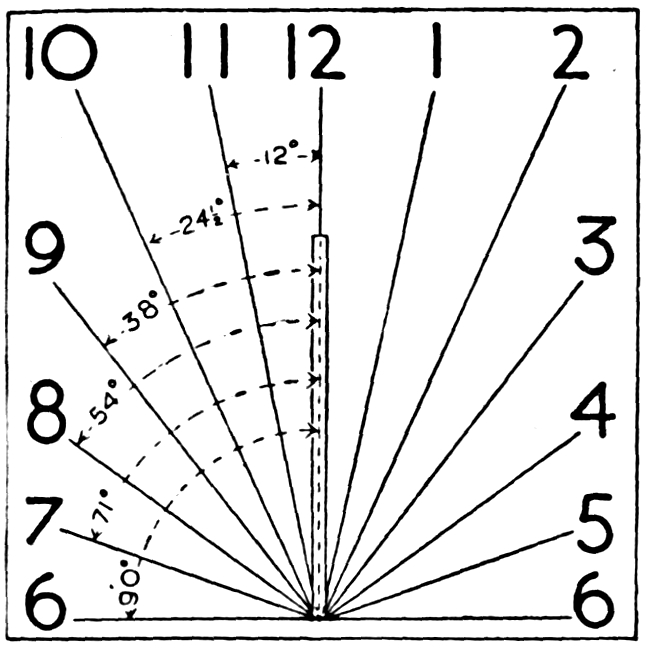
HOW TO MAKE A SUN-DIAL
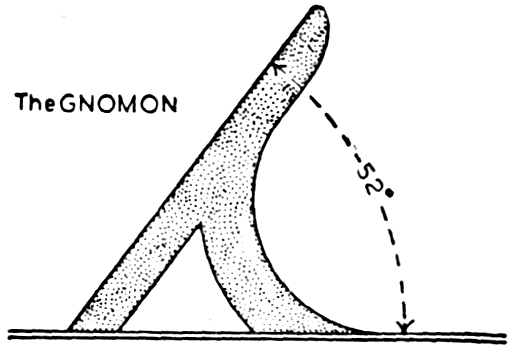
The above dimensions show how a sun-dial accurate enough for any place in the British Isles can be constructed. Place the 12 line exactly north and south. The sun-dial, of course, does not show Greenwich Mean Time; even at Greenwich it may vary by 16 minutes (without allowing for “summer time”). In addition it would be 4 minutes slow for every degree west of Greenwich.
Shadows are often very beautiful. Perhaps you did not think that shadows could be lovely? Ah, but they can! Trees cast purple shadows in the hot noonday sun, deep and glowing. Shadows on the white snow are blue. Shadows of clouds on the sea are deep purple. Moonlight shadows are black and mysterious. Look into shadowy depths, look at shadow and sunlight side by side, and see how lovely shadows can be.
THINGS TO DO
Make a Shadow Chart or Book and keep it each month.
Write down why a sun-dial is of no use on a rainy day.
It is interesting to examine the shadows cast by glass, especially thick glass prisms.
Draw a row of poplar trees standing in the evening sun. Put in their shadows. Draw the same trees in the noonday sun, with their shadows.
In this lesson I am going to tell you exactly how to plant bulbs and grow them in the classroom. We have all tried to grow bulbs, I expect—but not so very many of us have been gloriously and completely successful. This year we will all grow magnificent flowers, the pride of our classrooms, and the admiration of all the passers-by.
There are four ways in which we can grow our bulbs and corms. (A bulb, such as a daffodil, shows layers of fleshy scales when cut through, but a corm—that of a crocus, for instance—is quite solid.)
1. We can grow them in pots of earth.
2. In bowls of fibre.
3. In special glasses or vases, in water.
4. In bowls of stones and water.
I will take each method in turn, and when you have heard them all, you can talk about them and decide what you would like to do.
Our daffodils will grow splendidly in pots of ordinary soil. If you each want a daffodil to yourself, small pots will do, but better results are obtained if you get bigger ones and plant five or six bulbs in them. If the pots are old ones, you must scrub them well, inside and out. If they are new ones you must put them into water and let them soak for twenty-four hours. Then dry them before using. Get two or three pieces of broken pot and place over the hole at the bottom of the pot. If you don’t do this you will find that every time you water the plant, soil will run out of the hole with the water, and soon you will see your plant sinking lower and lower!
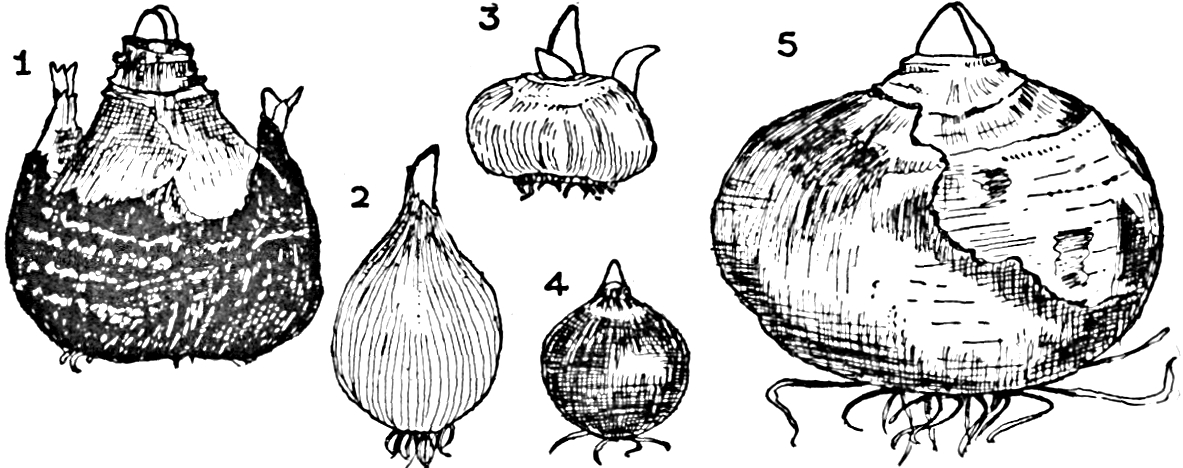
SOME BULBS YOU CAN GROW
1. Daffodil. 2. Tulip. 3. Crocus corm. 4. Scylla. 5. Hyacinth.
Now half-fill the pot with soil (which must be the best you can bring—not too clayey, not too sandy, but good black loam). Put your bulbs on the soil, quite close to one another, but not touching. Fill up your pot to within an inch of the surface, press down well, and then water thoroughly.
Next you can do one of two things. You can either put your pots out of doors in a bed of cold ashes (not new ashes, please) which is called a plunge-bed, and leave them there to make good root-growth; or you can put them away in a dark, cool, airy place—a cupboard, for instance.
Water them once a week, but do not let them get too wet. When the green noses of the bulbs are just over an inch high, bring them out into the light. Do not put them into the strong light at once. Put them into the darkest corner first, and bring them nearer and nearer the window. After a week or so they will enjoy any sunshine there is. Give your pots a little twist each day, or else you will find that the leaves all grow towards the light, and your plant will have an ugly, lop-sided look.
Water your plant when it needs it. You will know when to water it by feeling the earth at the top of the pot. If it feels moist and cool, no water is needed. If you think your plant is not doing as well as it should you can give it a little soot-water every few days.
The favourite way of growing bulbs is in bowls of fibre. How many of you have seen and handled bulb fibre? Perhaps you have some in class now. Feel it. Smell it. Isn’t it good! What is it made of? You will find bits of shell, sand, charcoal and peat fibre in it—and it is useful for growing bulbs in bowls because we can plant them without bothering about a hole for drainage. The charcoal in it will keep our bowls sweet.
You can buy cheap bowls, or you can bring one or two from home that can be spared. Now you must prepare the fibre for use, and I know you will love to do that. It comes from the shop in a dry, powdery state, and we must make it wet—which is not so easy as you might think, because every part must be equally moist.
You have all seen how your mothers stir milk into a cake mixture; we mix our water into the fibre just as if we were making a cake or pudding. Put it into a big enamel bowl and make a hole in the centre of it. Then stir round and round, and you will find that your fibre gradually becomes moist all over. Pour in more water as needed. The fibre must not be so wet that water can be squeezed out of it.
Now pack your bowls half full of damp fibre, and place your bulbs on it. Fill up with fibre to within an inch of the top to allow for future watering. Press down the fibre firmly. Then put away in a dark, airy place. Bring out when the shoots are just over an inch high, and water when needed.
The fibre should keep sweet and fresh, but sometimes it becomes mildewy because of too much watering, or too little air. It is difficult to tell when we have given enough water to bulbs grown in fibre, and as the water that is not taken up by the fibre collects in a puddle at the bottom, we must find some way of preventing over-watering. This is very simple. An hour after watering your bulbs, go to them again and tip them up carefully. Any surplus water will have collected at the bottom by then and will run out at the tipped side of your bowl. Don’t forget to do this, as it may mean all the difference between healthy flowers and weakly ones.
Hyacinths or crocuses may be grown in tall vases or glasses specially made for the purpose. Acorn-glasses may be used for crocus corms, so if you have any at school, use those.
The beauty of growing bulbs in water is that you can see the whole growth from beginning to end. There is a place at the top of the glass to put the bulb, and you must choose your biggest bulbs or else they will slip down the glass. Rest them on the curve of the neck, and do not let the bottom of the bulb touch the water. Put in a piece of charcoal, and then you will not need to change the water at all. All you will have to do is to fill up the glass occasionally when the water-level drops. You will be able to see the roots shooting from the bulb-base, and you can watch them growing longer and longer until they touch the bottom, and entirely fill the glass! The green shoot will appear at the top of the bulb, and soon it will open sufficiently for you to see the close-packed flower inside. What an exciting time that is! Then gradually the leaves grow longer, and the flower forces its way up, becoming coloured as it does so. And at last your hyacinth is out in all its beauty.
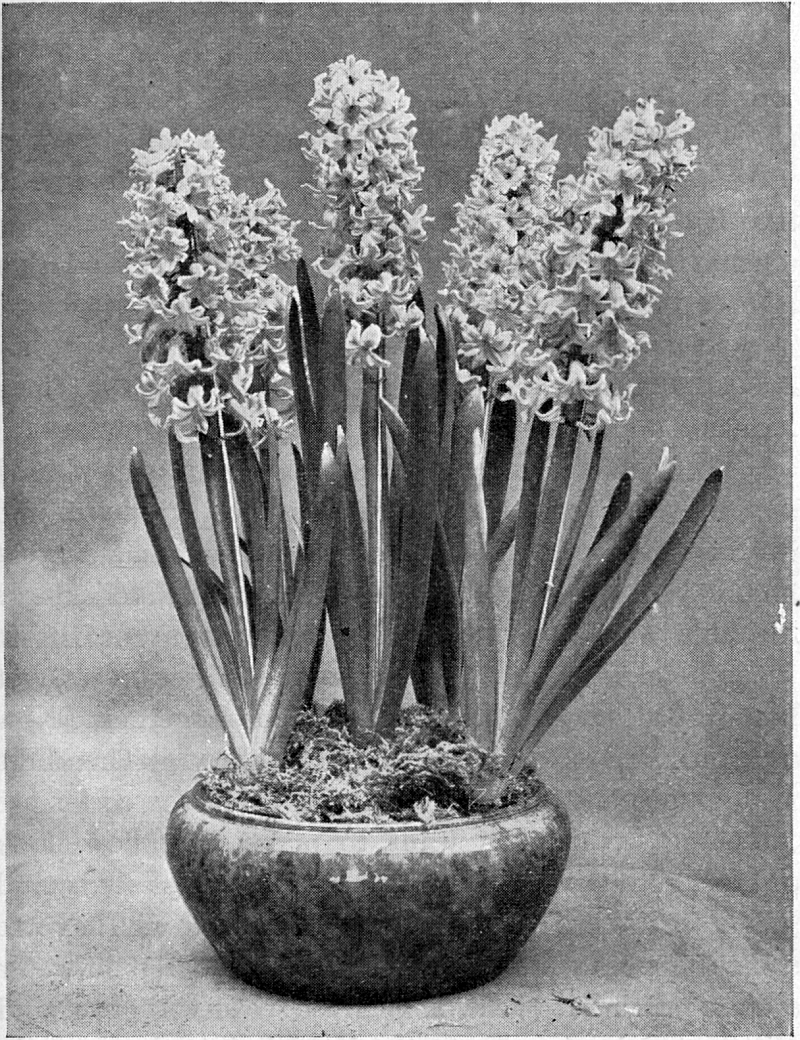
A LOVELY BOWL OF HYACINTHS GROWN INDOORS
You need not put away in the dark any bulbs or corms grown in water, as they will grow quite well in the light from the very beginning. Do not put them on the window-sill at first, but keep them on the darker side of the room. The flowers will be larger if you do put them away with the bowls and pots for a few weeks, so perhaps you would like to keep some out to see them growing and put away others for stronger growth.
You can grow crocuses in fibre or in soil—but I have always found that mine grew best in stones and water. Get a bowl and wash it. Then find a great many pebbles varying in size from a pea to a large thimble and wash them. Arrange them neatly in your bowl, and when you have about three layers, rest your crocus corms on top of them close together. Now pile on more stones to the top of the bowl. Then take a jug and pour in water until you think the corms are touching it. If you want to make your bowl look pretty, get a few bits of moss, or a few grass seeds, and plant in the crevices of the stones. You will have to take the moss out when it gets dry and soak it in water before putting it back. The grass seeds will grow, and give a touch of green to the bowl before the crocuses leaf. You can also plant grass seeds in your bowls of fibre, and the bright green grass-blades look very pretty round the growing bulbs.
It is exciting to watch the crocuses put out their white shoots, which soon become tipped with green as the leaves grow out. The shoots press their way between the stones whilst the roots below grow and take firm hold of the pebbles. Do not put the crocuses away in the dark. Stand them on the window-sill from the first. Let them have every bit of sunshine there is.
Weakly, “leggy” plants may be due to too much watering, or too weak light. If tips of flower-buds and leaves go brown, not enough water has been given. When bringing from the cool, dark place in which the bulbs were first put, be careful not to give too much warmth suddenly or too much light. Do not put in a draught or near a fire.
Make sure your “cool, dark place” is airy.
When buying bulbs, buy early, as then you will have the pick of them. It pays to buy a few good bulbs rather than many cheap ones. August is not too early to buy, but September is the usual month. Buy big, strong bulbs that feel firm to the touch, not soft. Bulbs are at their cheapest (for garden use) in the New Year.
Your fibre can be used again another year, so save it when you empty out the bowls. After your flowers are over, wait until the leaves turn brown (water weekly till then), and then plant the bulbs in a shady place in the school garden. They will flower next spring. You cannot use them for bowls again. Mark with a label where you have planted them.
Buy Golden Spur, Emperor or Sir Watkins daffodils. If you like the paper-white many-flowered narcissus, buy Grandiflorus. A very pretty little jonquil with yolk-of-egg coloured flowers is Odorus Campanelle. It has a sweet scent, and flowers early.
Roman Hyacinths flower earliest of all the bulbs, often round about Christmas time if planted in good time. When planting hyacinths, do not mix the colours, but keep all blue, all pink, etc., in the same bowl, as if you plant a pink, a blue and a yellow together, they will come out at different times.
You will find that the Duc Van Thol varieties of tulips are best for your bowls. If you like a pretty pink, try Cottage Maid, or a gay yellow, try Chrysolora.
When buying crocuses, be sure that in a mixture you are given plenty of yellow ones, as often you will get not a single one. It is best to buy the colours separately. Ask for a deep purple, a pure yellow, and a striped white, and plant in separate bowls.
Scyllas, aconites and snowdrops may also be grown in little bowls. Aconites come out very early indeed.
And now I think I have said enough to help you. Talk it all over, see what money you have to spend, and start right away!
In the clear autumn weather, when we go out into our gardens or over the fields in the morning, we may see a wonderful sight. A veil of fairy-like gossamer is spread over the countryside, and as the sun shines out the tiny threads gleam and shine. Where have they come from?
Hundreds of tiny spiders have chosen that morning to seek their fortunes! They want to see the world, they want to find a new home. And this is how they do it; let us watch one setting out on its great adventure.
First it climbs up to the top of a post or mounts to the top of a bush. Then it turns to face the little breeze, and we see that it is sending out four or five gossamer threads. The breeze catches them, and, as they grow longer, pulls strongly on them. The spider holds tight with all its legs to the post until it thinks it has let out enough thread to carry it safely. Then it lets go! Off it swings in the air, carried high by the breeze, which blows the filmy threads along.
If the breeze becomes stronger the spider hauls in some of the thread. If it drops, the spider lets out more thread! It knows just what to do. When it wishes to alight it hauls in its thread gradually and gently drops to earth. When hundreds of little spiders are out ballooning in this way the meadows become criss-crossed with their gossamer and are a beautiful sight to see.
You have all seen a garden-spider, with the curious whitish cross on its back, and you have all seen its marvellous web. Perhaps some of you have even seen a spider in the act of making its web. If you have, tell the others exactly what you saw.
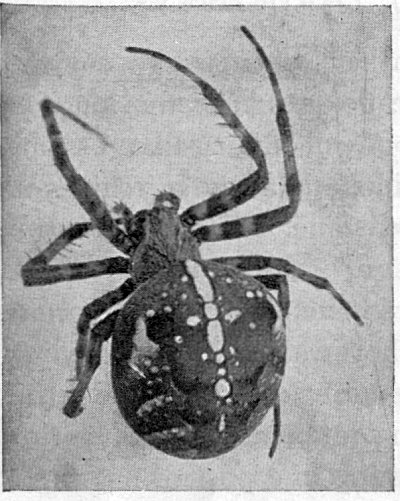
THE GARDEN-SPIDER. DO YOU SEE THE WHITE MARKINGS, RATHER LIKE A CROSS, DOWN ITS BACK?
Do you know how the spider makes its web? Where does it get its strong threads from? If we turn a spider upside down (quite an easy thing to do if you catch one and it pretends to be dead), you will see six little lumps on its body. These are its spinnerets—little bags of gummy fluid which it uses for its web. If we saw these bags under a microscope, which would make them look very large indeed, we should see that they had three or four hundred tiny openings, and out of these the gummy liquid is squeezed. As soon as it reaches the air it hardens into a strand of thread. The spider can make its thread thin or thick, sticky or not, as it pleases.
By touching a leaf or twig with its spinnerets and squeezing out thread at the same time and then moving away, the spider draws out a strand of fine silk, which becomes longer and longer the further away the spider goes. Now let us watch it make its web.
First it makes the foundation lines from twig to leaf and leaf to twig—the framework of its web. Then it goes to the middle of the top thread and drops a line from there to the bottom. Then it secures this to the bottom thread and climbs half-way up it to the middle. It begins to make the “spokes” of the web. When these are all finished it goes to the middle and begins to weave a rough spiral thread round and round and round until the outside of the web is reached. Then it makes the real spiral, working carefully from the outside to the middle, eating up the first spiral thread as it goes! On this second spiral are tiny drops of gum which entrap unwary flies and hold them fast as soon as they brush against the web. No other part of the web is sticky.
The web finished, the spider either plants itself in the middle or else runs up to a leaf to hide, and there waits patiently for its first victim. It runs a line from its web to its hiding-place, and as soon as something is caught and the web shakes with the victim’s struggles, the spider feels the pull on the line and at once rushes out to pounce on the fly. Should this warning-line be broken, the spider does not seem to notice when a fly enters its web. Its sight is poor, and it depends entirely on the vibration of the warning-line for news of its victims.
Here is a new web, just freshly made. Let us watch it. The spider is beneath that leaf at the top, waiting. Here comes a small fly. Zzzzzz! It is caught fast in the sticky threads, and the more it struggles the more tightly it is held by the web. The warning-line shakes and the spider rushes out. It kills the fly with its strong poison-fangs and sucks its blood. Then it goes back to its hiding-place.
Here comes a much bigger fly, and it blunders carelessly into the web. Out comes the spider, and sees that this time its victim is almost as big as itself. It must be careful. What is it doing? It is cutting the threads around the fly until it hangs suspended on only one. And now, look! It is twirling the wretched fly round and round like a bobbin, and at each twirl it lets out thread to bind him, until at last he is so well wrapped up that he cannot even move a leg! Then the spider poisons him and begins its horrid feast.
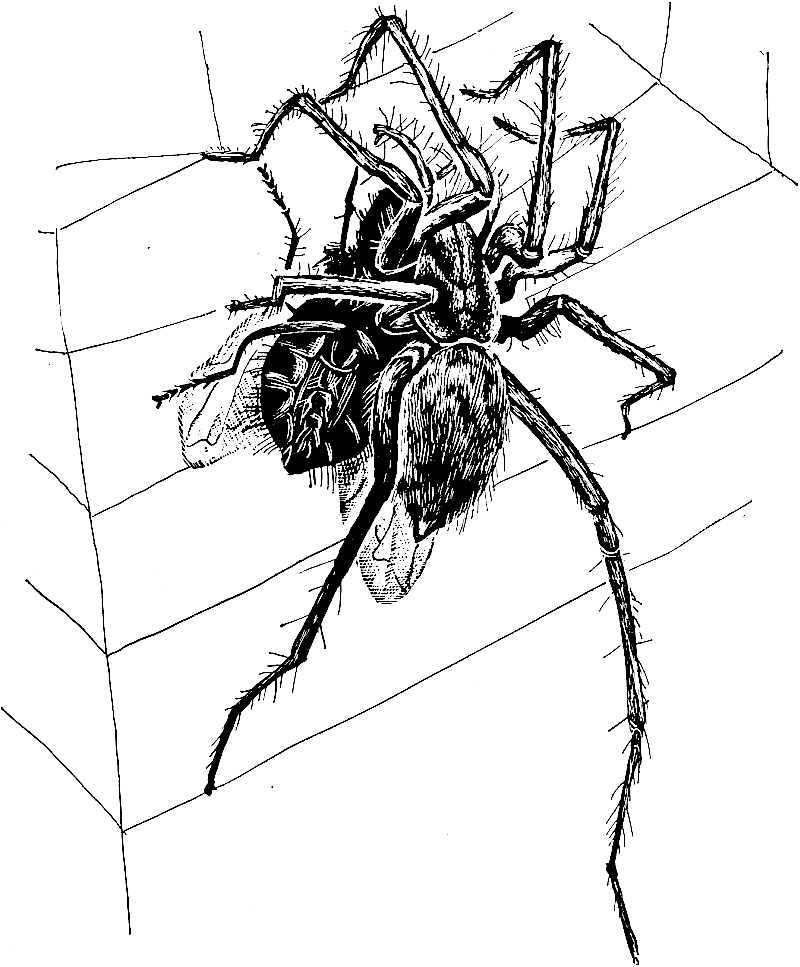
A SPIDER IN ITS WEB, STRUGGLING WITH A FLY NEARLY AS LARGE AS ITSELF
If a wasp or bee becomes entangled, the spider cuts the threads all around and sets the blunderer free. It does not wish to struggle with such a strong, well-armed foe.
Most people think the spider is an insect. It is not, although it passes its life among insects and behaves more like them than anything else. It belongs, not to the insect family, but to the scorpion and king-crab family, the Arachnids.
You can tell, by looking carefully at the spider, that it is not an insect. Insects have their bodies in three parts—how many has the spider? Only two. Insects have six legs, and the spider has eight. It has four to eight simple eyes, but an insect has compound eyes—like a number of little windows, each facing in a slightly different direction. An insect, too, such as a butterfly, for instance, usually has four stages of life—egg, grub, chrysalis, perfect insect—but a spider has only two, egg and spider!
The spider’s legs are long and hairy. At the end of each are two or three comb-like claws, and it is these that help it to run so nimbly over its web. Perhaps some of you are wondering how it is it does not get caught in its own web! It is because it keeps its legs well oiled! If we caught a spider and removed the oil from its legs, then put it back into its web again, it would stick to it just like a fly.
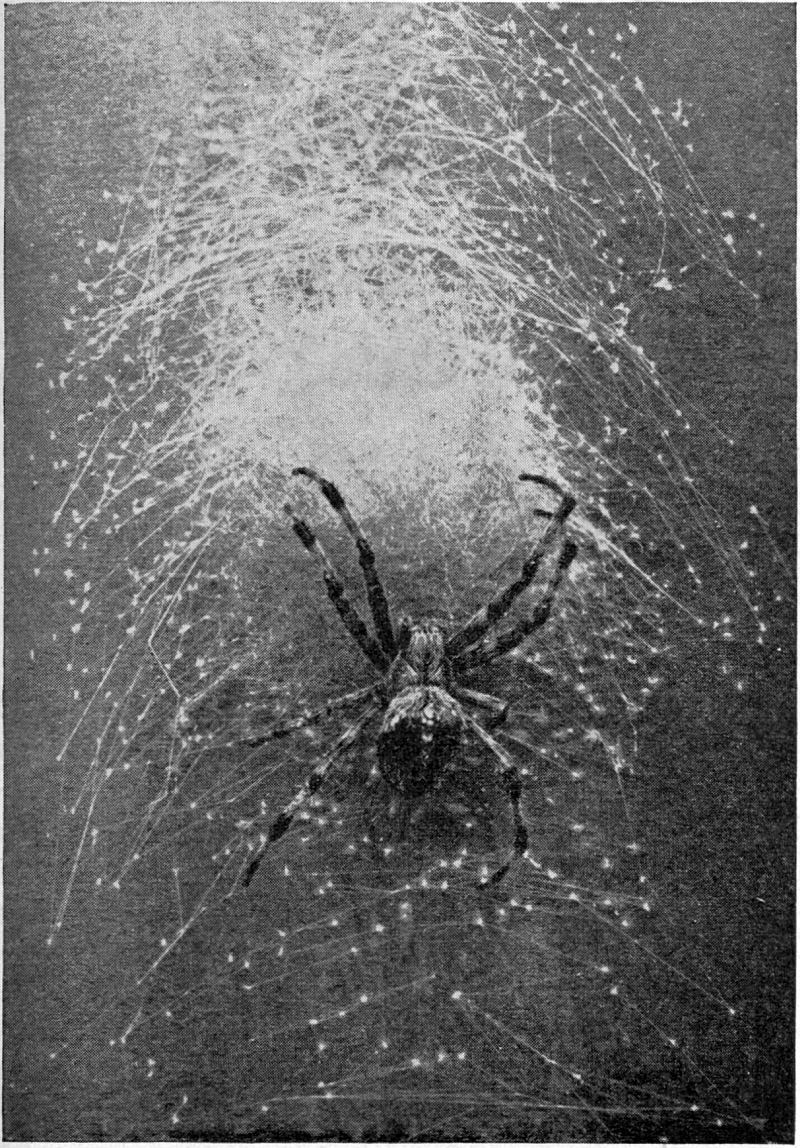
A GARDEN-SPIDER AND HER NEST
In September the spider is ready to lay her eggs. She spins a saucer of downy, orange-coloured silk, and in it she places two or three hundred round yellow eggs. Then she spins another little orange saucer and carefully places it upside down on the first saucer of silk, so that the eggs are neatly enclosed in a cocoon nearly an inch in size. It is left safely in a crevice of a tree-trunk or tucked away inside a hole in a wall or post.
In a fine autumn the eggs soon hatch out, but very often they remain eggs until the following spring, when they hatch out into minute orange spiders. You may then perhaps see a small amber ball hanging from a tree or bush, and if you touch it you will be astonished to see it dissolve into a crowd of tiny orange spiders, each hanging by a fine thread! As soon as they think the danger is past they clamber back together again, tucking away their legs, making a tight yellow ball! They will eat one another when small, but very soon they each take their different ways and find a place in which to spin a tiny web. In the autumn, as I have told you before, hundreds of them seek their fortunes by flying away in the air on fine, gossamer threads.
We have just been hearing about the garden-spider and its ways. Now we will talk about the house-spider and its web, which I am sure every one of you must have seen in the corners of your house. What is its web like? Is it like the garden-spider’s beautiful “cart-wheel”? No, not a bit! Its web is dark grey and dusty, usually built in the angles of the wall, and above it is a tangle of fine criss-crossed threads. It is these that entrap the flies for the spider. The grey web below is only a platform to catch the victims when they fall in their struggles. There the spider waits to eat its meal. It has a little tunnel near by with a back door and a front door—the front door it uses when it rushes out to seize its victim, and the back door is kept for flight if an enemy approaches.
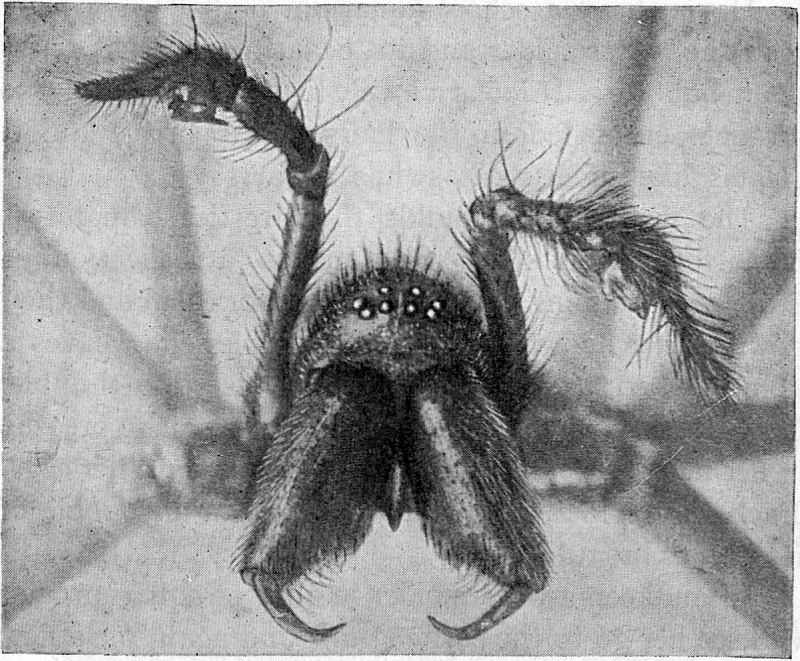
THE FACE OF THE HOUSE-SPIDER
She is not very pretty, is she? Do you see her eight eyes set in two rows? Look at her strong fangs too.
If you have a school aquarium perhaps you have seen the water-spider and its beautiful, fairy-like nest of air-bubbles. It looks a lovely little creature, because air gets entangled in the hairs on its body, and it gleams like silver as it swims about.
The water-spider builds the prettiest, quaintest home of air-bubbles! She makes a collection of bubbles, swimming up to the surface for them and then down to her home. Round the bubbles she weaves a dome-shaped, silken web, about the size of a thimble. Now she can live under water, for she has air to breathe in her nest! Here she lives, and here she lays her eggs. Each tiny spider, when hatched, has an air-bubble of its own to breathe!
If you keep a water-spider in a jar or aquarium you will see her go to the surface now and again for a new air-bubble to take to her nest.
There is not space to tell you about many other spiders. You may have seen the wolf-spider, which carries its eggs about in a white cocoon. When they hatch the spider builds a web in the bushes or grasses, and this acts as a shelter for the young spiders. The hunting spiders do not build webs as the garden spiders do, but hunt for their meals, stalking flies and leaping on them. Perhaps you have seen a little grey-black spider running about, rather zebra-like in colouring; this is one of the hunting spiders. Watch it stalking its prey. It runs nimbly along, stays perfectly still when it sees a fly approaching, and then, with a light jump, pounces on it.
I have said enough to show you that spiders are interesting creatures—and now I hope you will look out for them and watch them at their work whenever you can.
THINGS TO DO
Find a web and look at it carefully. Draw it when you get home, or, if you have a notebook with you, draw it straightaway.
If you can find a spider making or mending its web, watch it and then tell your teacher exactly what you saw.
Write down three things that tell you a spider is not an insect.
Pretend that you are a young spider going to seek your fortune, and describe how you will travel.
Look carefully at the first spider you see and draw it.
Try to find the old Greek story of Arachne and read it. You will know why you should read it when you come to the end.
Is it a rainy day? I hope it is, because this week’s lesson is all about rain! Look up at the sky. What is it like to-day—blue, cloudy, grey, black? Perhaps the raindrops are pattering against the window and the sky is purple-black with angry rain-clouds.
The rain comes from the clouds, of course. How does it get up there? What makes it? It seems rather strange that water should so often fall down from the sky, doesn’t it? We will find out how it happens.
Many of you have walked home through a thick mist or damp fog. When you got home you found that your coat was wet, although there had been no rain. The fog must have been wet enough to soak your coat. It was made up of water-vapour, just like the clouds. If we could walk through the clouds in the sky we should think they looked like fog, and we should again find that our clothes became damp. Clouds are simply mist or fog high in the air.
Does anyone know how they are made? It is an interesting story, and we will begin at the beginning. Think of a sunny day, when everywhere is hot. The pond in the meadow dries up a little. The puddles in the road disappear. The dew on the grass vanishes, and all the washing on the line becomes as dry as a bone. The hot sun has taken away the wetness, it has stolen the moisture from everything.
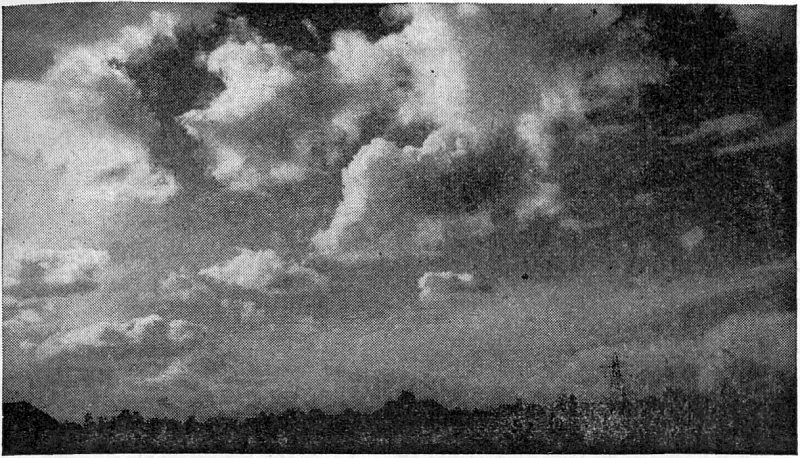
PERHAPS YOU CAN SEE HEAVY RAIN-CLOUDS LIKE THIS FROM YOUR CLASSROOM WINDOW TO-DAY?
From the puddles, the ponds, the sea and the rivers the sun has drawn up millions and millions of tiny drops into the sky. The water in the puddles, the dew on the grass, the dampness in the washing have all evaporated—that is, changed into water-vapour, or water-gas—and risen into the air.
This water-vapour makes the clouds we see floating in the sky. Sometimes the clouds are high and thin, and we know they are not heavy enough to pour down rain. At other times they are low and thick, and we expect rain at any moment from them. But what makes the clouds turn into rain? Why don’t they float about as clouds for always?
When water-vapour comes up against something cold it shrinks and begins to run together as tiny drops of water. Clouds may reach a cold layer of air, a cold wind may blow on them, or they may even float against a cold mountain-side. If any of these things happen they condense—that is, they turn back into drops of water—and, of course, these are heavy and cannot remain high up in the sky. So down they come in a shower, and we say, “Oh, it’s raining!”
Is this difficult for you to understand? Let me say it shortly again, and you will then be able to picture in your mind all that happens. First, there are the ponds and puddles drying up in the hot sun, which makes them evaporate or turn into water-vapour. This rises into the air, and after a time makes the clouds we see floating in the sky. As soon as they come in touch with something cold—cold air or a cold wind, for example—they shrink and condense into little drops of water, which, when they become too big and heavy to stay up in the sky, fall down on our heads as rain. The rain makes the puddles, swells the ponds and rivers and soaks the trees. Out comes the sun again and once more begins to draw up the moisture from them—and so begins again the rain-circle that goes on year in and year out!
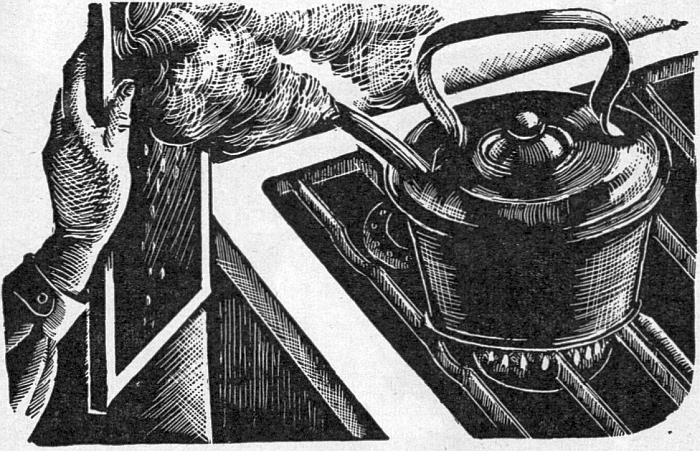
Have you a kettle boiling away on the fire or on a gas-ring? It will help us to understand what we have been learning. See how the spout is steaming! We will take a plate or, better still, a slate, if we have one, and hold it against the clouds that puff from the kettle-spout. What is happening? Look! The slate is soaking wet. Hold it there a little longer and we shall see drops of water running down it. What has happened?
The water-vapour from the kettle touched the cold slate, shrank and condensed into little drops, just as the clouds condense into rain when they reach cold air or a cold mountain-side. Take off the lid of the kettle. That has little drops on it, too, hasn’t it, although the water in the kettle was not high enough to reach the lid. But because the lid was colder than the bottom of the kettle the steam condensed and the lid was covered with drops that fall back into the kettle to be boiled once more!
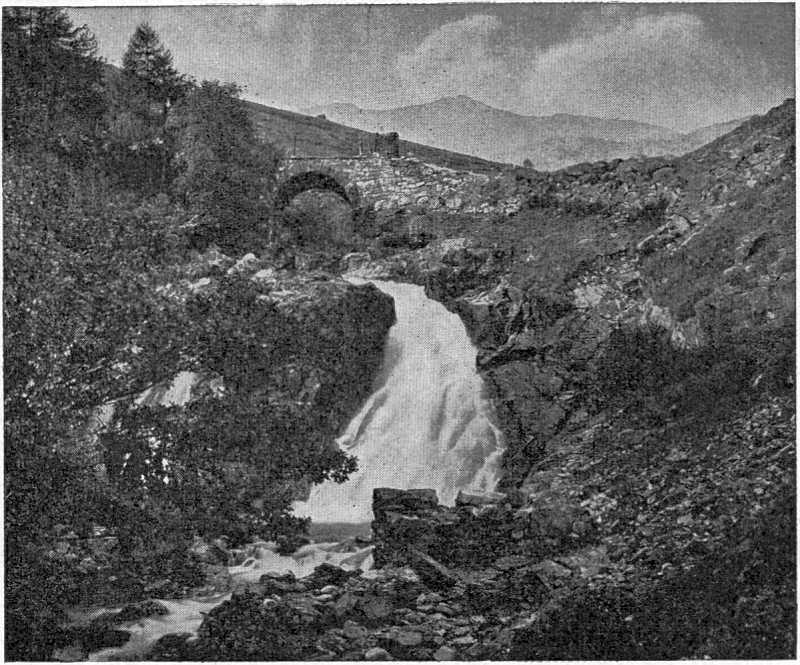
A STREAM TUMBLING DOWN THE SIDE OF A MOUNTAIN
We need the rain’s help. Trees and plants cannot grow without it. Seeds will not swell and germinate unless the soft spring rain helps them. Roots cannot grow until the rain softens the hard earth for them and gives them the moisture they need. Countryside wells are filled by the rain, farm ponds and streams, too. As it falls the rain cleans the air for us, laying the specks of dust and grime, washing the roads and the pavements.
When rain falls on the mountain-side it sinks down and after a while gushes out again as a spring, which, tumbling down the mountain, becomes a tiny stream. This is soon joined by others, and in a short time a brook is made. This in its turn is joined by many more, and at last we get a grand river making its way to the sea. If we could trace it right back to its source we should find it in the little rain-springs that gush out after a heavy rain-storm on the mountain-side.
THINGS TO DO
Write out part of the paragraph that begins “Is this difficult for you to understand?” Begin at “First, there are the ponds” down to “year in and year out.”
Watch Mother take off a saucepan lid at home, when she has boiled something in the saucepan. Is it wet or dry?
Look at a puddle on the morning of a sunny day, and look at it again in the afternoon. Is it as big as it was? What has happened to it?
Draw a picture of a mountain. Put a cloud over it, and show the rain falling. Draw springs coming out of the mountain-side, and let them join together to make a river that goes to the sea. Draw the sun shining over the sea, and put tiny dots to show how the moisture is being drawn up from the river and sea to make clouds. Colour your picture carefully.
Are you surprised to hear the worm called a ploughman? I wonder if anyone knows my reason. Think what a ploughman does. He runs his plough through the earth and turns it up, so that the soil underneath comes to the top. The worm turns up the soil too, doesn’t it, and so, in its own humble way, ploughs it for us.
You all know what a worm is like, but I wonder how many of you have actually picked one up and looked at it really closely. Let us take a worm and look at it with sharp eyes. What can we see?
It has a long, round body, and if you look closely you will see that one of the pointed ends is rather flatter and blunter than the other. That is the tail end. At the other end is the mouth. The whole body is made up of rings, and if you could count them you would probably find about 150.
Put your worm on to a piece of paper and watch it. It moves by stretching out the rings at its head end and then squeezing them close together, and this action makes the tail end of its body move to catch up the front part. Did you hear a faint scratchy noise as the worm moved over your paper? Lightly run your finger under its body, and you may be able to feel the tiny bristles that grow, four pairs at a time, from each ring. These little bristles act like feet, for the worm uses them to hold on to the ground as it moves along.
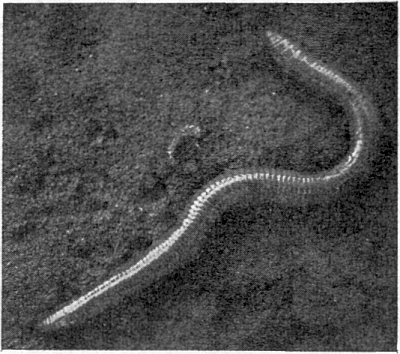
AN EARTHWORM COMING FROM ITS BURROW
The end on the left is still holding tightly to the burrow.
Although the worm has no eyes, it knows the difference between darkness and light, and can tell when it is safe to leave its burrow and when it is better to stay hidden for fear of sharp-eyed birds. It is able to smell, though it has no nose, and will burrow towards food near by. It can feel vibrations, though it cannot hear, and when it senses the movements of a hungry mole mining through the earth looking for worms or grubs, it hurriedly glides towards the surface to avoid being eaten.
Can you think why a worm is so moist and slimy? It is because it breathes through its skin, and if it should become dry it would be suffocated. The slime helps it to slide rapidly through its burrows, too.
A worm eats a number of things. It enjoys a good dinner of decayed leaves, it will feast on old roots or on anything it comes across, such as a scrap of meat, onion skins, potato parings, and so on. If there is no food of this kind handy it feeds on the earth itself, eating it as it is, digesting the tiny eggs or seeds in it and casting out the soil in the form of the worm-casts we see so often in our gardens.
Have you ever picked up a worm-cast? The next time you see one on a dry, sunny day, pick it up and crumble it in your fingers. You will find that it is very fine indeed. The worm’s body has reduced it to powder! Can you think whether that helps the farmer or not? Is it a help to us in our gardening? Yes, a great help! When we plant our seeds they thrive in the fine, powdery soil at the surface, thrown up by the worms.
Is it not strange to think that all the ground we walk on out of doors has been through the bodies of countless worms! Throughout the centuries the tiny ploughmen have been steadily at work, and bit by bit they have thrown up to the top of the earth the soil from below, passing it through their bodies and casting it out powdery and soft.
This is wonderful work, humble and small though the workers are. The stale, sour soil is brought up from the depths and exposed to the air. The tunnels made by the worms bring air to the soil below, and make little waterways for the rain, and they also help to loosen the soil, thus making it easier for roots to pierce downwards.
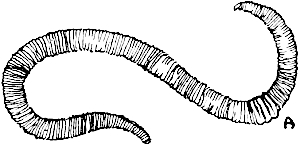
AN EARTHWORM TAKEN FROM ITS BURROW. A. IS THE SADDLE—A FEW THICKENED RINGS
The worm has a very small home. It lives in a narrow tunnel made by itself, usually slanting away from the surface of the ground. At the end of it is a tiny room, an enlargement of the tunnel, and here the worm curls itself up during the day. When night comes it goes up to the surface for food, hanging on to its hole by its tail whilst it ranges round about, seeking for dead leaves to feast on, or any other dainty. If you shine a light upon it you will see that it quickly slides back into its hole and disappears.
In cold weather the worm burrows deeper to escape the frost. It also plugs up its hole very tightly so that the cold and the rain cannot reach its hiding-place below, and birds are prevented from spying it and hauling it out. Have you seen the plugged-up worm-holes? They are most interesting. You will find dead leaves, bits of roots, straw, feathers, grass-cuttings, petals—in fact, almost anything used to plug up the holes.
Are there pine-woods near you? Or have you a pine-tree near by, whose needles lie on the ground? Go and look beneath the tree. You will find that the worms living in the soil there use the pine-needles as plugs. The pine-needles are in pairs, each pair joined at the base—and the worms are clever enough to know that they must pull into their hole the base of the pair of needles! They have found out that if they try to pull in one end first the needles will stick half-way. Do go and see this curious fact for yourselves if you can.
This habit of plugging up their holes with decaying leaves is of great help to farmers and gardeners, because the leaves act as manure to the ground and make it fertile. The worm is certainly a great friend of ours!
Now we will make a wormery and watch what the worms do. Get a large glass jar and fill it with moist earth. Collect a few big worms and put them into the jar. Keep the earth moistened every few days. Put the jar in a dark cold corner and they will tunnel along the sides of the glass. At night they will throw up their castings and you will find them in the morning, earthy rings neatly cast on the surface of the soil. If you like, you can collect them day by day, dry them and weigh them, but if you do this you will need a fair-sized box of earth for your worms.
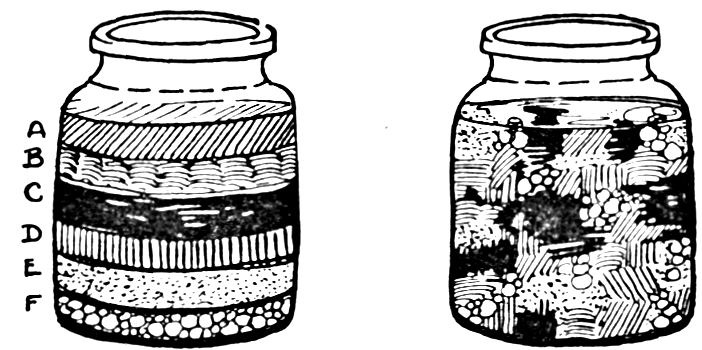
A WORMERY
Left: A Wormery before worms have lived in it. There are six different layers of material, A-F.
Right: The same Wormery after the worms have lived in it for some time. They have mixed up all the layers by their tunnelling.
You must keep another wormery, too, to show how the worms mix up the earth in their tunnelling. Get five or six different substances, such as clay, charcoal, sand, chalk, fibre, gravel, and put them in even layers, one after another, in a glass jar. See that they are moist, of course. Put in the worms. Now you will see an interesting thing happening day by day. Those straight, neat layers will gradually become crooked as the worms tunnel here and there—and in the end they will all be so much mixed up that you will hardly know which is which! This is a very interesting experiment, and one I know you will like to try.
You can make yet another wormery, to see the way in which the worms plug up their holes. Fill a big jar with moist earth, press it down, and put in your worms. Stand the jar in a very cold place, or the worms will not plug up their holes. Put on the surface of the earth in the jars a collection of different things, such as one or two dead leaves, a live leaf, bits of straw, a bit of string, a few petals, a few stalks, a couple of pine-needles, and a few tiny pebbles. The next morning, you will see that the worms have been hard at work, and have chosen some of the things you left them to plug up their holes.
And now I hope that after all you have heard about the good deeds of the worm, you will say next time you see one, “Pass, friend, all’s well!” instead of chopping the poor creature in half with your spade!
THINGS TO DO
Go out one night with a torch and see the worms outside their holes. Watch them hurry back when you shine the light on them.
Draw a worm, showing how its body is ringed from end to end. Look at one carefully, before you colour your drawing, to see what colour it really is.
Write down three ways in which worms help the farmer or the gardener.
Write down two enemies of the worm.
Unplug a worm-hole in your garden, take it carefully to pieces, and see what it is made of. Tell your teacher next day.
The autumn is an exciting time in the world of plants and trees. Millions of seeds are going out to seek their fortunes! They cannot stay at home even if they want to, because the mother-plant has already arranged how they shall travel to their new homes.
Why must they go? They are so small and a hundred fates await them! They may be eaten, they may fall on stony ground, they may decay in the rain and damp of autumn. Surely it would be better for them to stay near the mother-plant, for she found safety where she grew.
“No, no,” we can imagine the big plant saying, or the tall tree rustling, “there is only enough space, air and moisture for me here—if all you seeds sprouted by me we should die of suffocation! Trees would kill their children if the seeds sprang up in the shade of their branches; and if all the seeds from one dandelion grew in a patch together not one would be strong or healthy! No, you must go far away from us and start your life as best you may.”
Seeds travel in many different ways to their new homes: the dandelion with its little parachute flying in the wind; the sycamore and its papery wings; the haws on the may trees, scattered about by birds. What others do you know?
We will make a little plan showing the different ways in which seeds get about.

A great many plants and trees find that by trusting their children to the wind’s care they can be sure of having them carried a long way away. So they grow wings for their seeds. We have already spoken of the sycamore, and you are sure to know its double-winged fruit. Throw one into the air and watch it sail slowly to the ground. Now take off its wings and throw up the little lump that is left. It falls almost straight to the ground, which shows that the little wing is very useful, especially on a windy day. Have you some ash-keys or “spinners” to examine? The elm-tree, too, uses wings to help its children on their travels.
Some plants use plumes for their seeds, instead of wings. These are easily caught by the breeze, which takes the seed far away. You know the pretty little silken parachute of the dandelion quite well. The thistle grows a parachute too. The old man’s beard in the hedges gives a silvery-grey plume to each of its seeds, and the willow-herb, splitting its thin pod into four from the top downwards, sets free dozens of tiny seeds, each with a downy plume.
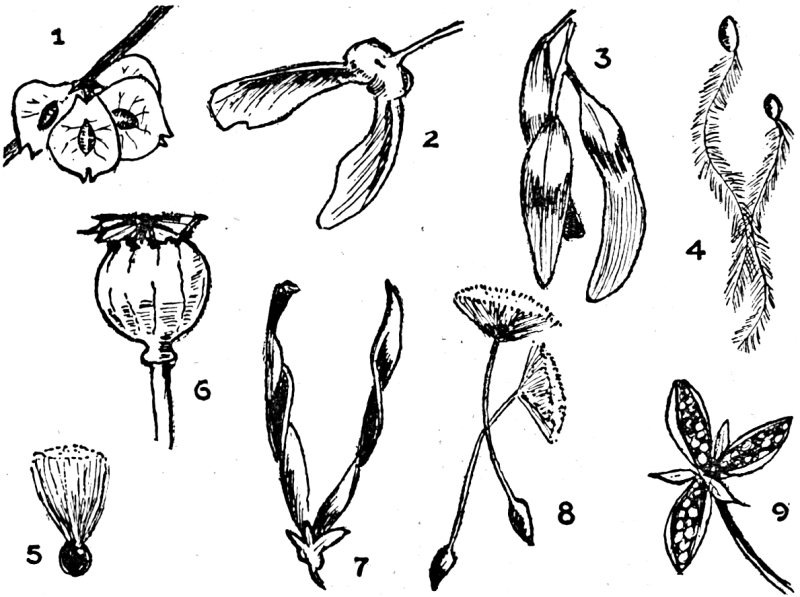
SOME SEEDS TO FIND
1. Elm. 2. Sycamore. 3. Ash. 4. Old Man’s Beard. 5. Thistle. 6. Poppy. 7. Sweet-pea. 8. Dandelion. 9. Violet.
Have you a poppy-head to look at? Do you see that overhanging ridge at the top? Look just underneath it, and, if the head is ripe, you will see a great many little holes. Tip the head upside down, and out pour the little black seeds! On a windy day the breeze shakes the poppy-head violently, and the seeds fly out.
Who can think of any seed that uses the water to help it on its travels? I expect someone will say “The water-lily,” and someone else will be sure to have heard of the clever coconut! Water-lilies send their seeds floating through the water of the pond, each provided with an air-space to help it to float. At last, when they are some distance away from the mother-lily, the seeds sink into the mud, and there begin to grow.
The coconut, which grows by the seashore of hot countries, uses the sea to send its children away. You all know the coconut in its thick, light coat of fibre, do you not? I wonder if you have puzzled over the water inside it—or coconut milk as we call it. I will tell you why it is there. As perhaps you know, salt water kills young plants, and the coconut palm does not dare to give the fruit a coat that can be penetrated by the sea. Therefore it has a water-proof coat—but that means, of course, that no fresh water in the form of rain or other moisture can help the seed to sprout! So what is to be done? “That’s easy!” we can imagine the coconut palm saying, “I’ll put a supply of fresh water inside the seed! Then it can help itself to it when necessary.” The coconuts roll down the shore to the sea, and the tide takes them away to another island, where they germinate and grow into palms.
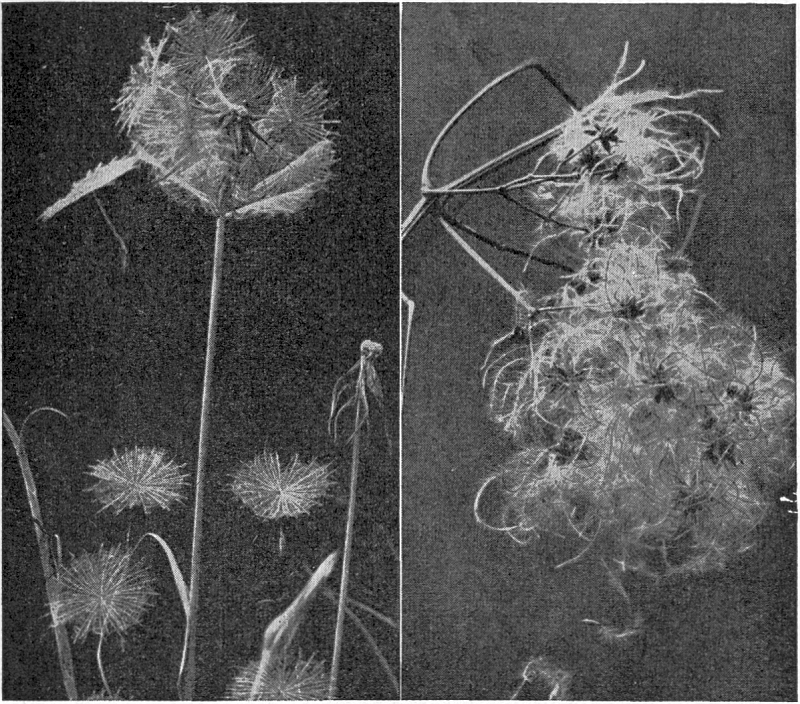
TWO PLANTS AT SEED-TIME
Left: The “puff-ball” of the Goat’s-beard sending away its fruits on their feathery parachutes.
Right: The feathery plumes of the seeds of “Old Man’s Beard.”
Perhaps you are puzzled to think how the sun helps the seeds to travel. It helps some of them in this way—it dries the seed-boxes and, by making them split or explode, the seeds are forced out with a jerk. Do you know any plant that does this? If you have ever sat on a common near a gorse bush on a hot summer’s day you will have heard a great many little explosions going on all round you, and perhaps even felt something strike you. The noise is made by the gorse-pods shooting out their seeds! The hot sun has dried the pods and they have suddenly split and twisted, sending out the seeds very sharply. The sweet-pea does this, too.
The violet has a different way. Its seed-box splits into three little boats, and as the sun dries the boat-like cases, forcing the edges together, the seeds are shot out with great force. Take an orange-pip between your finger and thumb and press it. Whizz! Away it goes—and in just the same way the violet seeds shoot out from their seed-box. The pansy does the same thing.
A great many fruits make themselves juicy, sweet and bright-coloured. The apple is one of these. Right inside it are the little brown seeds, very well protected by the fleshy apple outside. Until the seeds are ripe the apple is green, hard and sour, and no bird is likely to peck it, or human being to eat it. But as soon as the apple is ready there is no lack of eaters! We eat the sweet, juicy part and throw away the hard core that protects the seeds. This is what the apple meant us to do. “Scatter my seeds for me and I will give you a feast!” it says.
The hips and haws do the same for the birds. They prepare a brightly coloured, juicy outside, a feast for the thrush and blackbird, but inside they pack their precious seeds, which are not to be eaten by the birds—or, if they are, will pass right through the bird’s body and be cast out far away from the parent plant. The hip makes its seeds hairy, so that the birds do not want to eat them. The haw puts its seed in a stone, like the plum and the cherry, for protection. The gooseberry makes its seeds slippery. But all make their outsides enticing and sweet, to persuade the birds to peck them.
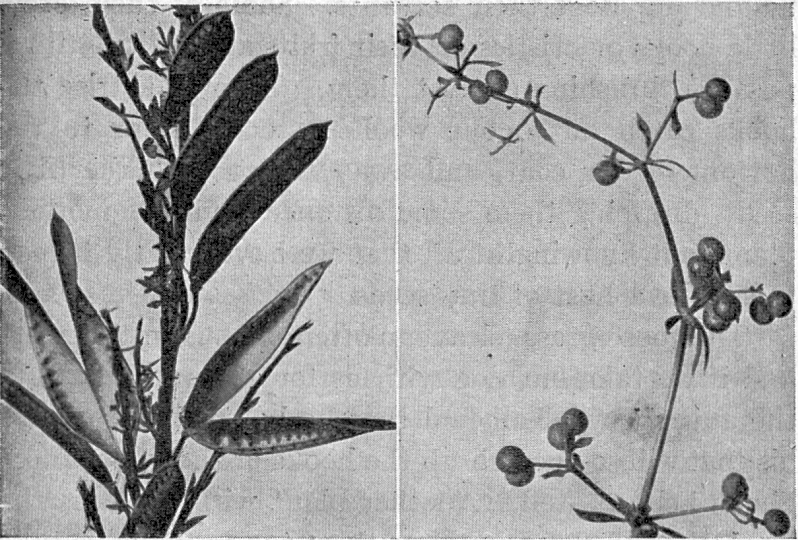
TWO MORE PLANTS AT SEED-TIME
Left: Seed-pods of the Broom. The pods suddenly explode and the seeds fly out. The lower pods have burst and the seeds are gone.
Right: Fruits of Goose-Grass or Cleavers, set with hooks that catch on to our clothes as we pass by.
The plants have another way in which they make us and our dogs their servants. Some of them grow little hooks or bristles on their fruits and wait until we pass by, brushing against them. Then in a trice the hooks catch on to our woollen stockings, or to the bottom of our coat, and away we go with the little seeds, dropping them some distance from the mother-plant, not knowing at all that we have greatly helped to scatter a host of tiny seeds.
The goose-grass (cleavers) often uses us in this way, and if we take our dog with us for a country walk in the autumn we shall find that he has to help too, for his coat will soon catch up the hooks of the goose-grass. Sheep help as well. Another plant with hooks is the burdock, and the geum uses them too to make us take away its seeds.
It is fun to plant seeds that we have collected ourselves. Go into your gardens, and into the lanes and fields, and look at the plants. If any are seeding, take the seeds and put them into an envelope. Write the name of the plant on it. Then put them in a dry place for next year.
THINGS TO DO
Copy out the Seed-Table neatly.
Write down the names of six plants, and put by each the way in which it sends away its seeds.
Draw a sycamore key, a dandelion parachute and an apple.
The squirrel helps to scatter the fruits of one tree. How does it do this?
I wonder how many of you have noticed the different kinds of clouds in the sky. Most of you, I expect, because at some time or other you must have wanted a fine day very badly, and you looked at the sky anxiously to see if it was blue or covered with clouds. Some clouds bring us rain, others sail away without sending down even a drop—do you know the difference between the two? Once you learn to notice the clouds you will find that you are becoming quite a weather-prophet.
In another lesson we learnt how a cloud was made. Do you remember? When the sun draws up moisture from the puddles in the road, from the rivers, the ponds and the seas, the moisture rises into the air and becomes clouds. The water that has evaporated from the earth is changed into water vapour or water gas, and we see tiny particles of water floating high above our heads in big heaps of clouds, or in small cloudlets that seem hardly to move. A cloud is simply a mist or fog high up in the air. If we flew through it, we should be as wet as when we walk through the misty fields, or through a fog that hangs little beads of moisture on our coats.
Clouds are lovely things. Their shapes are strange and beautiful, their colours are often magnificent, and they seem almost alive as they hurry through the sky, changing their forms as they go, or saunter along very high up, like tiny feathers floating lightly on the air.
The different kinds of clouds you see have different names. I cannot tell you all of them, because it would muddle you—but I will tell you the commonest ones, and you must look out for them and watch them. You must also notice various things about them—how high they are, what colour, and whether they travel slowly or fast.
Have you ever looked up in the sky and seen little wispy, curly clouds, very high up? They may be feathery looking—like goose feathers—or streaky, or brush-like. They are pure white clouds, and their name is cirrus. When I tell you that cirrus means “curled hair” you will see what a good name those little curly, wispy clouds have. They are usually fine-weather clouds. So high up are these clouds that they are made of little clusters of ice.
Below the cirrus clouds come the woolpack clouds, heaped-up masses like packs of wool. Their proper name is cumulus, which means a heap. I am sure you all know the cumulus clouds, for you must often have said that you thought some clouds looked like masses of cotton-wool.
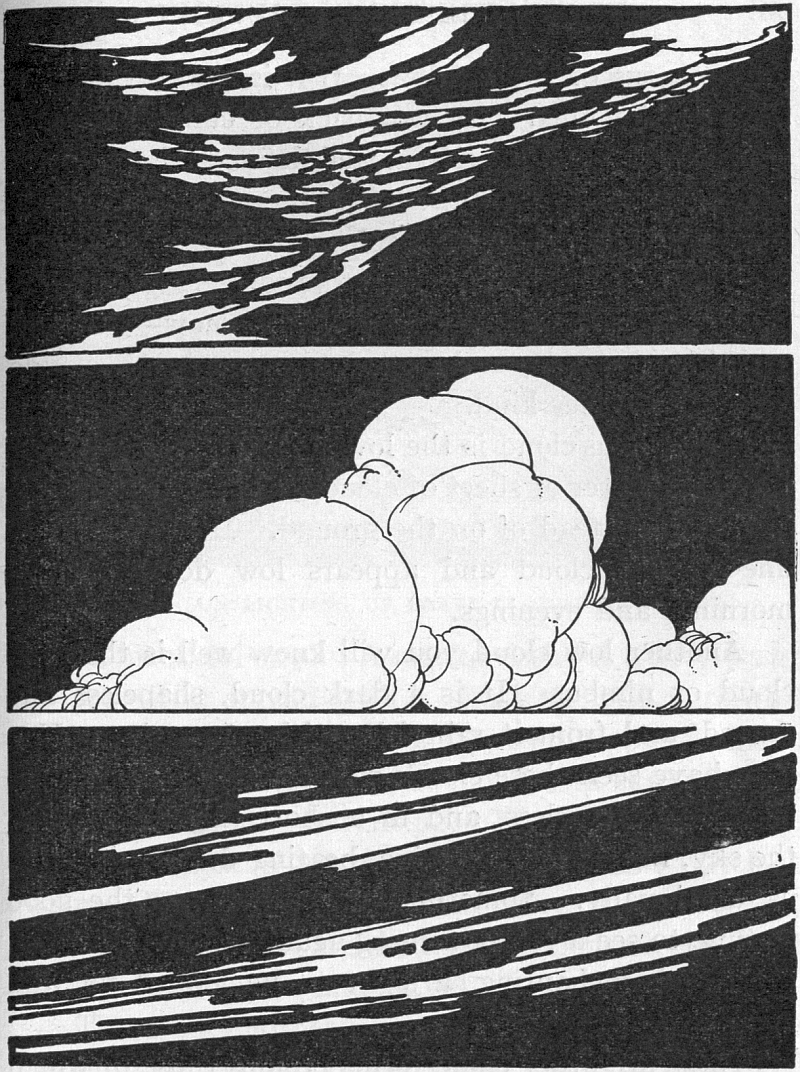
THREE KINDS OF CLOUDS TO LOOK FOR
Top: CIRRUS. Middle: CUMULUS. Bottom: STRATUS.
Look out of the window. If it is a warm day the sky may be filled with woolpack or cumulus clouds, heaped up high, with sharp, well-defined edges. They have lovely shadows in them, and these make the clouds look very solid. What colour are the shadows? Bluish? Purplish? Look hard and see.
That is two sorts of clouds we know—cirrus or curled-hair clouds, and cumulus or woolpack clouds. Now for another kind.
The stratus cloud is the lowest kind of cloud. It is a uniform layer or sheet of cloud, rather like a fog, but in the air instead of on the ground. It is generally a fine-weather cloud and appears low down on fine mornings and evenings.
Another low cloud you will know well is the rain-cloud or nimbus. It is a dark cloud, shapeless and ragged, and from it rain falls without ceasing. You may have seen these clouds rushing up from the west, black and shapeless, and in a short time they cover the sky, ragged and lowering, beating down rain upon us continually. Sometimes you may have the good fortune to see a rainbow hung against their blackness, vivid and enchanting, a sight to be looked for and remembered.
There are other cloud-forms besides those of which I have told you, but they are mostly mixtures of these kinds. Do you know the clouds that make what we call a mackerel sky? A mackerel sky is a lovely sight to see—it is spread with a shoal of little pure-white speckles or flocks of clouds arranged in ripples or waves. When the mackerel sky is touched with sunset pink or gold it is most entrancing. You are sure to see mackerel skies in warm weather, so please watch for them. The French call a mackerel sky “a sky of sheep,” so white and pretty are the flocks of little clouds neatly arranged in ripples and waves.
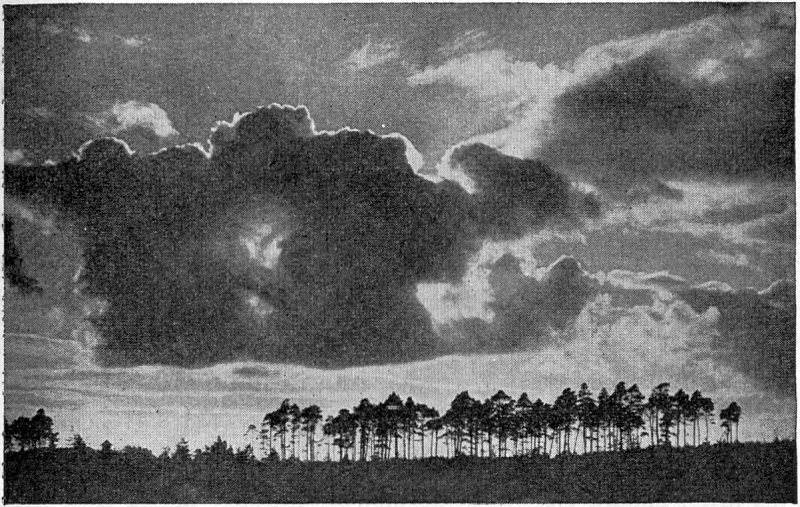
THE SUN LIGHTING UP HEAVY CLOUDS AT SUNSET
There is another lovely sky which the French people call the sky of big sheep. It is rather like a mackerel sky, but the clouds are not so fine-looking, nor are they pure white. They are fleecy-looking, and each little cloudlet is dark in the middle. Sometimes you may see this sky at night, with the moon shining brightly in the midst of big waves of little clouds that cover the greater part of the sky.
On a fine summer’s evening look high up in the sky and see if you can find mares’-tail clouds. They are really cirrus clouds blown by the wind into long wispy tails, like the tails of horses. Are they going slowly or fast? Watch and see.
Who knows the thunder-cloud when he sees one? It is a mixture of the woolpack cloud and the rain-cloud. Have you seen a cloud towering up like a mountain in the sky, rising up in monstrous towers, giant-like and threatening? That is the thunder-cloud, often seen before a thunder-storm. “Beware!” it seems to say. “Beware! I have thunder and lightning in my heart!”
As the clouds sail smoothly and silently through the sky they change their shapes. Sometimes they alter swiftly, sometimes they throw out wispy fingers, or leave feathery streaks behind them. They change because of two things—the wind and evaporation, due to reaching warmer air. The big woolpack clouds often alter their shape very quickly, and are fascinating to watch.
The loveliest skies are seen at sunset and at sunrise. Who has been up early enough to see the sun rise on a summer’s morning? Did you peep out of the window and see the sky? Perhaps it was deep gold, with every cloud painted to match, or maybe it was rose-pink with the eastern edges of each cloud beautifully tinted. Watch for the sunset skies too, especially those of you who live by the sea, for then the sinking sun not only paints the sky but the waters also, and you will be amazed at the marvellous spread of glowing colour.
THINGS TO DO
The first chance you have go to a hillside and watch the clouds.
Keep some sort of chart or notes of the clouds you see.
Write this down:
Evening red and morning grey,
Help the traveller on his way.
Evening grey and morning red
Pour down rain upon his head.
Draw three sorts of clouds you know. Use white chalk on tinted paper.
Write down a full description of the clouds you see from the window to-day, remembering to give height, speed, colour and shape.
On a fine dry day lie down on your back in a field or on a hill and watch the clouds sailing by far above you.
Boys and girls have many different pets to care for—rabbits, guinea-pigs, pigeons, canaries, ponies, donkeys and white mice—but the most usual pets are cats and dogs.
A cat and a dog are very different. How are they different? Do they eat and drink in the same way? Do they fight the same, play the same, hunt the same? Not a bit! We really could not have chosen two animals more different from one another for our pets than the cat and the dog.
Look at their paws. Listen to the cat as she treads across the floor. Can you hear her? No, she doesn’t make the tiniest sound. Now listen to the dog. What a noise he makes! Can you hear his claws clattering on the floor as he runs? Why is the cat so quiet and the dog so noisy? Look underneath their paws and you will see why.
The cat has soft little pads to walk on. Feel them. Her claws are pulled well back so that they do not touch the ground as she runs. She wants to keep them as sharp as needles, and she knows that if they rub continually against the ground they will soon get blunt. Look at her back claws. They are not so sharp as her front ones. Why?
Now the dog’s paws. What great, hard pads he has underneath! And look at his big, blunt claws, that strike the ground as he runs. He cannot pull them back as the cat can—but he doesn’t want them to be sharp, so he doesn’t mind. He uses them for digging, very often, and sharp claws would be of no use to him for that. He likes to go for long walks, or to scrape about for rabbits or rats, so he wants hard pads that will not get sore or tired. The cat doesn’t like to go walking. Her feet soon get tired, for her soft pads cannot stand much wear.
The cat keeps her claws carefully drawn back into a sheath for protection. Only when she scratches or pounces on something does she put them out—and what damage those pointed, curved weapons can do! Watch her when she stretches herself and puts out all her claws as she does so—aren’t they long and cruel-looking?
A dog loves to lick your hand. He has a smooth tongue, and we don’t mind his affectionate lick. But a cat’s lick is very different! It is like a rasp or a file—if she licked us for long we feel that she would lick our skin away! Even a kitten’s tongue is rough.
All the dog family have powerful teeth, but smooth tongues. All the cats have sharp and rough tongues. When the dogs eat they crunch up bones and meat together—there is nothing left to lick, so their tongues are smooth. But when the cats eat they cannot crunch up big bones—they can only eat the meat. They gnaw some of it off the bones, and the rest they scrape off with their rough tongues, leaving the bone clean and bare. Their tongues are studded with lots of little hooks, all pointing backwards, and it is these little hooks that make their tongues feel so rough.
The dog makes a great noise of gobbling and gulping when he eats, and he can empty his dish in two minutes! The cat never hurries, not even if the dog is just behind her, ready to gobble up everything. She nibbles daintily, and laps slowly.
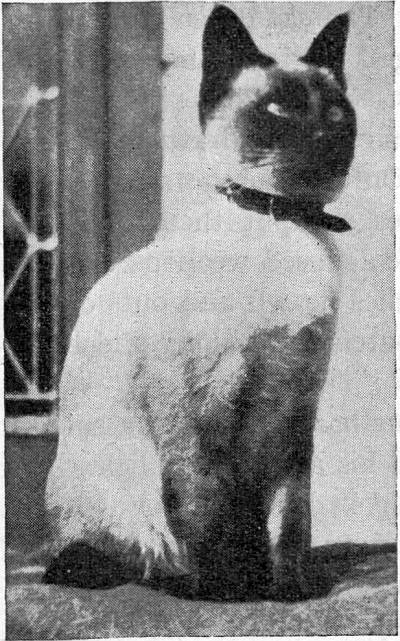
PAT, MY SIAMESE CAT
When these animals were wild, long long ago, they learnt their table manners then, and nothing will alter them now. The dog hunted in a pack with other dogs, and when they found food, they all fell upon it at once. They did not wait for one another—any dog who waited would find nothing left! So they all gobbled and gulped in a hurry, and the dog cannot stop himself from doing the same thing now.
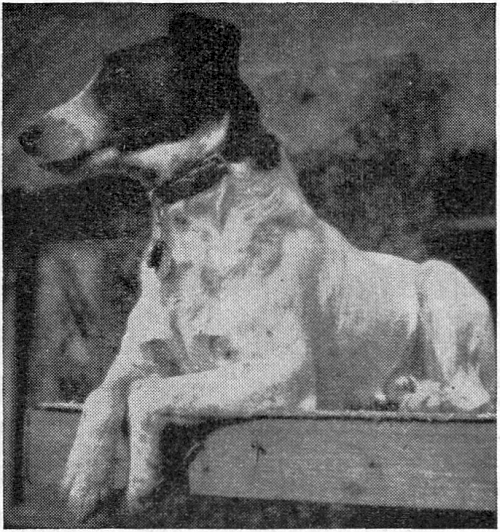
BOBS, MY SMOOTH-HAIRED TERRIER
But the cat did not hunt in a pack. She hunted alone, and ate alone. There was no need to hurry. She could nibble and gnaw as she pleased; and she does the same still, and will never learn to do any differently. The ways she learnt when she was wild still stay with her now she is tame.
When your dog lies down, does he turn himself round and round first? My dogs always do. Long ago, the wild dogs used to sleep in reeds or in rough under-brush, and before they could get comfortable they had to tread down their beds to make a nice smooth place. It became such a habit with them that to this day our dogs still turn themselves round and round when they lie down—even if they are only going to lie down on a hard piece of linoleum!
Have you noticed that when your dog is angry, he growls and raises up all the hairs at the back of his neck? But when your cat is angry she hisses, and raises up the hair all over her body! Why is this? It is because a dog, when he fights, likes to get hold of his enemy’s neck, and, to protect himself from being seized there, he raises up his scruff to make it thick and tough. A cat strikes another cat anywhere she can, with her claws, and to protect herself she raises up all her hairs, so that no matter where she is struck she is protected. She also fluffs out her tail to twice its size, and by raising all the hairs on her cheeks, makes herself so alarming that it is surprising her enemy stays to fight!
Cats have fine whiskers, but dogs have only poor ones. A cat has need of hers and uses them, but a dog has no use for his, so they are poor and feeble. A cat hunts at night and squeezes herself through many a crack and many a hole. She does not want to make any noise, and her whiskers tell her whether or not she can get through a bush or a hole without sound. How do they tell her? Well, they are just about the size, tip to tip, of the width of her body. If they are bent back by the bush or the sides of the hole she is trying to squeeze through, she knows she will not be able to get her body through without noise. So she draws back her head and pads round another way. If her whiskers only just touch the sides of the hole she knows she can get through quietly, and she does so.
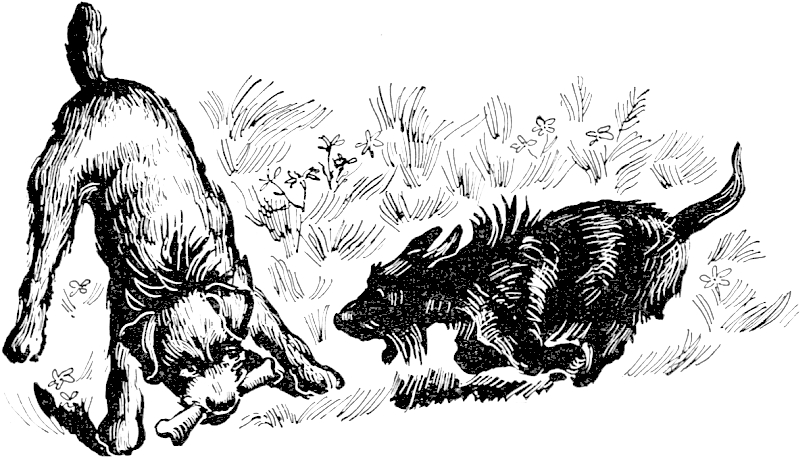
WHEN DOGS FIGHT THEY RAISE UP THE HAIRS ON THE BACKS OF THEIR NECKS. WHY IS THIS?
So, you see, her whiskers act like eyes to her in the dark. A dog does not hunt at night, nor does he try to be quiet, so he does not need big whiskers. Dogs hate to be alone in the dark. They are afraid some enemy will get them, so they are always on the watch, listening for the slightest sound. If they hear the softest footstep they bark loudly—and this makes them good watch-dogs. Cats would let a dozen burglars into the house.
People will tell you that a cat can see in the dark. She cannot see in the pitch-dark, but she certainly can see in the ordinary dark of night-time. Her eyes are made in such a way that they can take in every single ray of light there is, however poor. Look at your cat’s eyes now. Do you see that straight slit of black? Look at the eyes of the girl or boy next to you. He has a black circle in the middle of his eyes, hasn’t he? It is called the pupil of the eye. In bright sunlight our pupils get small—in a dark corner they swell and become large to take in all the dim light there is. The cat’s eyes work in the same way.
At night-time that black slit expands until it covers the whole eye—and the cat sees quite well, even though the night seems very dark to us. The big black pupil gathers in every ray of light there is, and the cat sees all it needs.
A dog is a splendid friend and an eager alert companion. He soon learns to obey, he is always ready for a game, and he will do almost anything for his beloved master. What makes him such a good friend and comrade? Well, before we took him for a pet, he lived with many others of his kind, and they roamed about together. The dog learned to obey his leader and to respect him. He learnt to play with his comrades. He became a good comrade himself. Now he has no dog-leader to follow and obey—so he loves and respects his master instead. He is still ready to play, but with us, instead of with the pack.
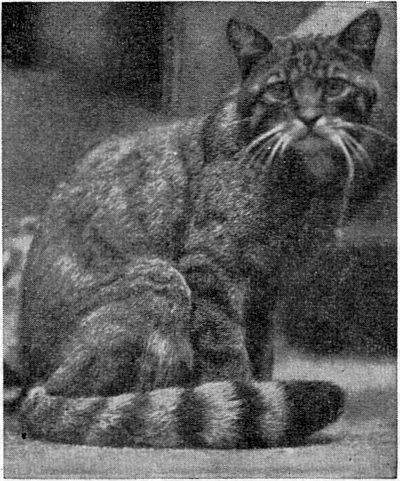
I LOOK TAME AND PEACEABLE, BUT I AM A WILD CAT, AND NO ONE WILL EVER SUCCEED IN TAMING ME
The cat is quite different. She will only play if she wants to. She will rarely come when she is called except at meal-time. She will only be friendly if she wants a warm lap to sit on. These “standoffish” ways she learnt before she became a household pet, for when she was wild she lived by herself, as we heard before. She did not learn comradeship and friendliness as the dogs did. She thought only of herself, and it is difficult for her to learn new ways.
A cat lashes her tail from side to side when she is angry, but a dog wags his when he is pleased. Watch two dogs meeting one another. They are each afraid that the other is going to bite. See how stiff they make themselves, ready to fight. Their hair rises on their necks, and their tails are still. Then one of the dogs begins to wag his tail, the other dog sees it and wags his! It is a signal that “All’s well!”
When you meet a strange dog you must remember that you have not a tail to wag to tell him you want to be friends, and if you suddenly put your hand out to stroke him he may think you are going to hit him, and he will growl. Let him sniff your hand, and watch for his tail to wag. As soon as it does, say “Good dog!” and he will be your friend. But ALWAYS wait for his tail to wag, and never make a sudden movement to a strange dog, for remember that he doesn’t know whether you are friend or enemy, because you haven’t a tail to signal to him with.
There are some silly children who think it is fun to tease an animal, and until a cat or dog knows that you are the right kind of child, not the wrong, he will be wary of you. But animals soon know when children like them, and are eager to be friends.
THINGS TO DO
Write down two ways in which a cat and dog are different.
Pretend you are a dog gobbling down a meal. Write down how it was that you learnt such bad manners.
Pretend you are a cat. How do you manage to hunt so well at night?
Draw a cat and a dog, and give them names.
Write down the different kinds of dogs you know.
Take a dog out for a good walk when you can and try to make him a friend.
I am sure there cannot be a single boy or girl in the whole of the kingdom who does not know the cheeky house-sparrow. You have seen him every day. He eats the rubbish in the road, he steals the corn from the farmer’s fields, he hops jauntily about our gardens, and he is the first to visit our bird-tables to see what he can find there. Only the boy or girl who lives in very hilly districts, or in some of the islands of the Outer Hebrides, will say they do not know him well.
We know him well—but who can describe him exactly? What colour is his head? What colour are his cheeks? Has he a dark eye-stripe? Does he wear a dark bib? Are his wings barred?
Look at him carefully next time you see him. Perhaps he is on your bird-table now, so just examine him closely while I tell you what to notice.
First, the cock-sparrow is darker than the hen, so if you see a dull-coloured sparrow it will be a hen. But I want you to see a cock, because, unless he lives in the heart of a city, he is quite a handsome bird. Ah, there is a cock-sparrow on the bird-table! Look at him. See his slate-grey head, and the slate-grey colouring at the root of his tail. Look at his white cheeks and dark bill. Do you see a few dark feathers flecking his pale grey chest? Those dark specks are all that is left of the bold black bib he puts on in the spring-time. It is easy to tell which are cock-sparrows and which are hens, then, for no hen-sparrow wears a black bib. Do not forget to watch for the dark bibs when the New Year comes. You will see them gradually appearing on the cock-sparrows’ chests.
His wings are bright chestnut brown, and you will see a white bar on each. The hen-sparrow’s wings do not show the bar so clearly. Her dress is much duller, but her voice is just as loud!
In the olden days the sparrow was called Philip Sparrow because he seemed always to say “Philip! Philip!” Some people think he says “Chissic!” and some are quite sure he says “Chillip!” What do you think he says? I have heard him say all three at the top of his voice all day long, for he is a most talkative little bird, who loves the sound of his own voice! The young sparrows talk a great deal too, and in the summer-time the garden is filled with their cheerful chirrupings, when most of the other birds are silent.
Listen to your sparrows and find out what they say. They have no proper song such as the thrush and blackbird have. Besides their chirrupings they have a very harsh alarm-note, which you may hear when your cat disturbs them. It sounds like “kwurrrrrrk!” or “churrrrrrrr!”
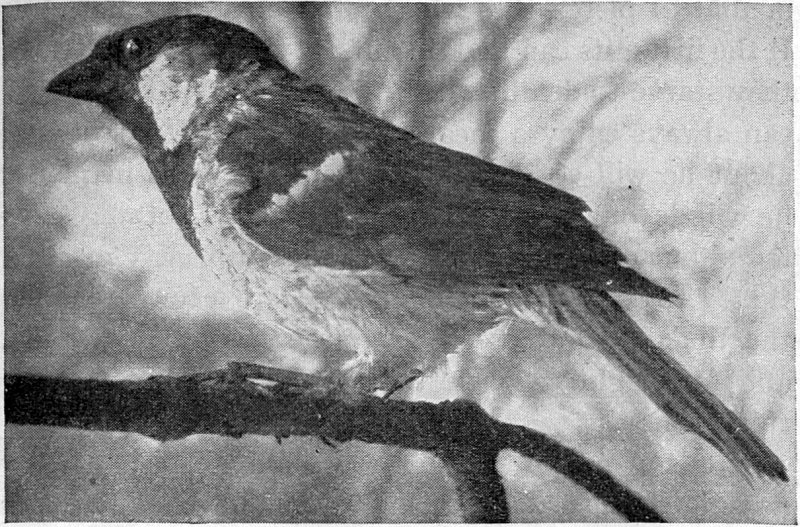
THE HOUSE-SPARROW. DO YOU SEE HIS STRONG BEAK?
What do your sparrows eat? If they feast on your bird-table you will soon have noticed that they ate anything and everything. They will gobble up the seeds, they will devour the potato scrapings, feast on the soaked bread and finish up the crumbs of fat left by the starlings.
It is because they will eat anything that there are such great numbers of them. In a hard winter many of the insect-eating birds perish. The kingfisher, unable to pierce through the frozen water, dies, too. If the little tits can find no nuts or fat put out for them they starve to death. But not the bold sparrow! He can always enjoy a meal of some sort. If insects are about he will eat them. If there are seeds in plenty he will devour those, too—and if there is nothing to be found but road rubbish, he will make a hearty meal off that. He pokes his little dark beak everywhere, spies the tiniest crumb, sees when the peas are ripening, and is delighted when the farmer’s corn is getting ripe.
He is a sharp little bird, wary and suspicious. He does not trust us, and this is why he never becomes as tame as the friendly robin. He likes to live near us, he likes to build his nests about our houses if he can—but he does not want to make friends. The robin will soon be tame enough to fly to our shoulders, or to sit on the arm of our garden chair—but the sparrow will rarely be tamed, and looks at us suspiciously out of his sharp black eyes.
All the seed-eating birds have the same strong, heavy-looking beaks. Watch a sparrow rolling a hard seed round and round in his beak, trying to break the husk and get at the kernel inside. Then crack! His strong beak splits it at last, the husk is spat out and the seed swallowed. Some seeds are very hard indeed, and the sparrow is glad of his strong beak, for he would miss many a good meal if his beak were as weak as the swallow’s is.
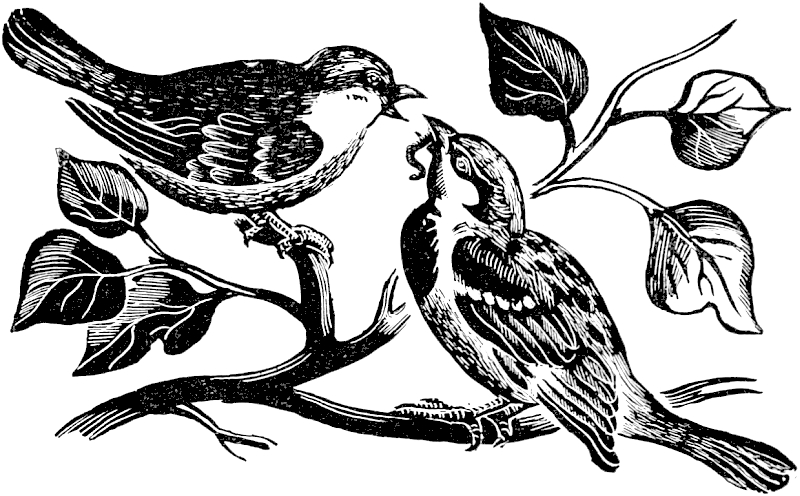
THE COCK SPARROW BRINGS A TIT-BIT TO HIS MATE
What a nuisance the sparrow can be! Has he ever visited your garden in the spring-time and nipped off your primrose heads or spoilt your yellow crocuses? He comes to my flower-beds in February and thinks he will lay low all my pretty crocuses—but I know his little ways, and I place strands of black cotton here and there over my flowers. As soon as he feels his feet entangled in the cotton, the cheeky sparrow gets a fright, and flies into the air at once. He warns all the other sparrows, and they leave my crocuses alone!
The sparrows nip off fruit-buds, too, and pull up young seedlings, especially peas. When the corn is ripening in the fields, great hosts of them migrate there, and the farmer is not pleased to see them, for they peck out the grain of the corn and scatter as much as they eat, destroying the value of the crop wherever they go. I often see sooty, dirty little sparrows in the cornfields here in the late summer, and I know that they are the town sparrows come to join their country friends in a feast of corn.
In the springtime the sparrow makes up for some of the harm he does by eating harmful insects and grubs and taking them to his young ones. He also eats the seeds of weeds when he finds them, so that in some ways he helps us—but I am afraid he hinders more than he helps!
Many of you will have had a sparrow’s nest built under the eaves of your house, perhaps at the top of a gutter-pipe. You will certainly have noticed one thing about it—and that is its untidiness! As long as the nest holds together and is warm and soft, that is all that matters! His nest is lined with scores of soft feathers, and he likes it. He robs the hen-roost at nesting-time, and haunts the pigeon-house. A very bold sparrow actually went so far as to hop behind one of my pigeons that was basking on the grass in the sun, and tug at a feather in its tail!
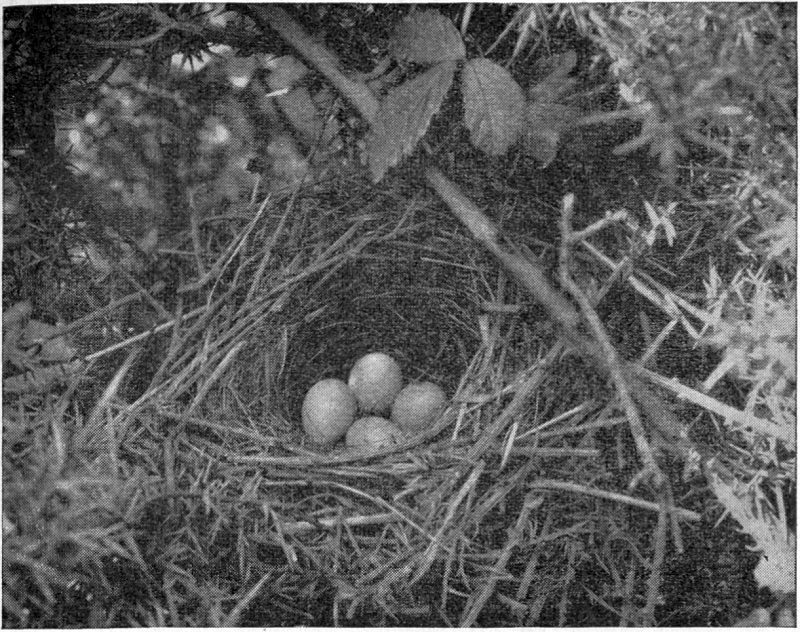
THE HEDGE-SPARROW’S NEST WITH EGGS
Sparrows build in many queer places. They prefer to build somewhere about our houses, in a hole in the thatch or wall, or in the ivy. But one pair actually built their nest in the cartridge-box of a gun-carriage—and the gun was fired off each day! It must have been a very noisy home. Another pair built a most curious nest near a clockmaker’s, making it entirely of watch-springs discarded by the man at his work.
Sometimes the old nests of other birds are taken. Often a house-martin returns from the warm lands to the place where it nested the year before, only to find that its old nest is occupied by sparrows, who have lined it with wool and feathers. Indeed, the little robbers will even turn out house-martins from a new nest if they want it, and smash the eggs. They will build in the bottom of old rooks’ nests, and rob woodpeckers of their holes. If they build in trees they make a domed nest with an entrance at the side, near the top.
I expect you know the eggs quite well. They are usually grey-white speckled with black, brown or grey. The hen lays two or three clutches each year, and in the late summer our gardens are full of little Philip Sparrows, all chirruping at the top of their shrill little voices.
THINGS TO DO
Look at a cock-sparrow carefully. Draw him and colour him.
Listen to the chirrup of a sparrow and tell your teacher what you think he says.
Write down three ways in which a sparrow makes himself a nuisance to us.
Why does the sparrow have such a strong beak?
Look out for a sparrow’s nest in the early spring, and watch how it is made, noticing what is used for it.
Printed in Great Britain by Richard Clay and Company, Ltd.,
Bungay, Suffolk.
Mis-spelled words and printer errors have been fixed.
Inconsistency in hyphenation has been retained.
Some faded photographs have been enhanced.
[The end of Round the Year with Enid Blyton—Autumn Book by Enid Blyton]